Applying Timmons model of the entrepreneurial process
VerifiedAdded on 2022/12/29
|18
|5284
|33
AI Summary
The Timmons model of entrepreneurial process considers the opportunities, teams, and resources as three main factors for success. This article explores how Apple applied this model and the importance of opportunity identification in business.
Contribute Materials
Your contribution can guide someone’s learning journey. Share your
documents today.
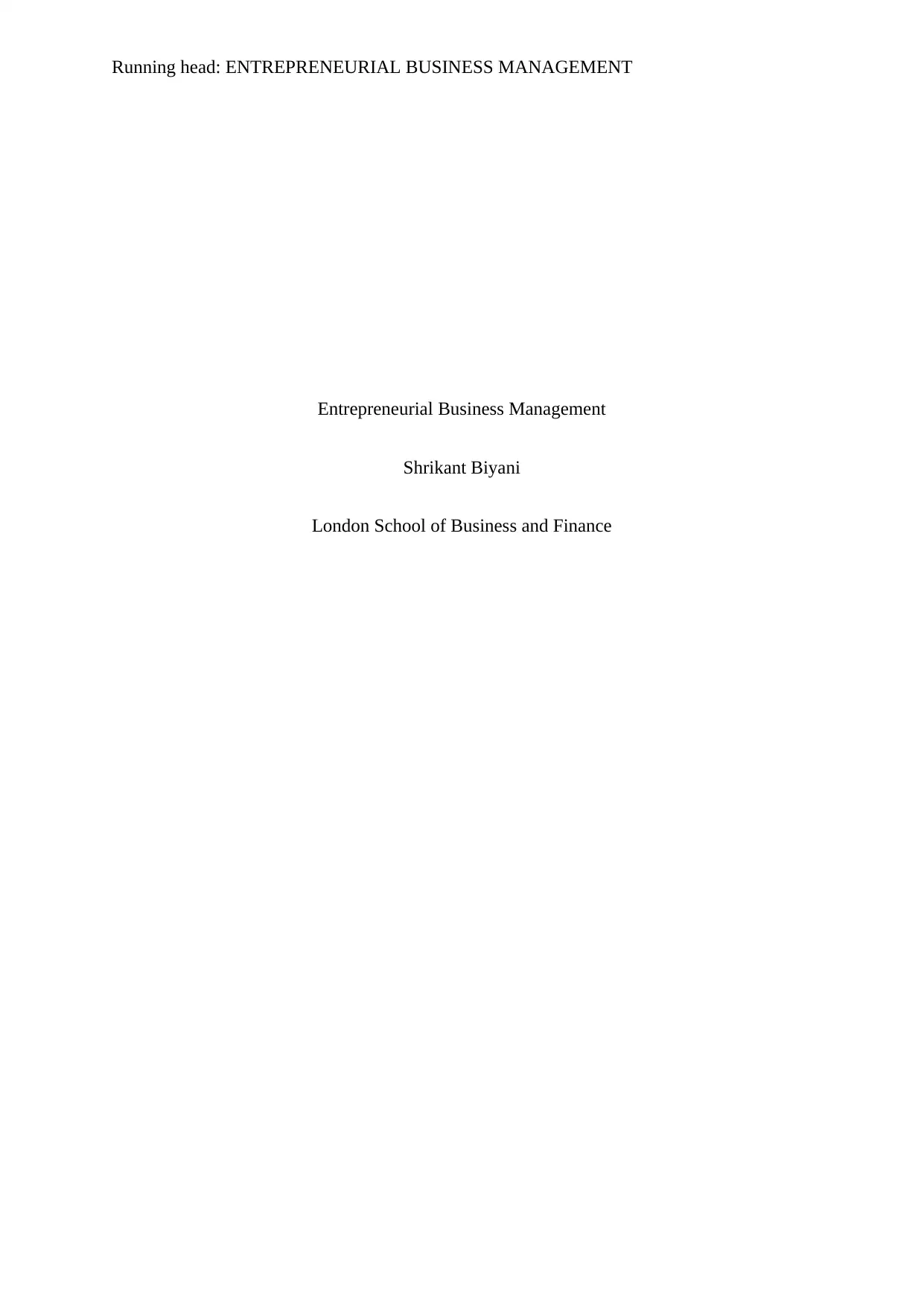
Running head: ENTREPRENEURIAL BUSINESS MANAGEMENT
Entrepreneurial Business Management
Shrikant Biyani
London School of Business and Finance
Entrepreneurial Business Management
Shrikant Biyani
London School of Business and Finance
Secure Best Marks with AI Grader
Need help grading? Try our AI Grader for instant feedback on your assignments.
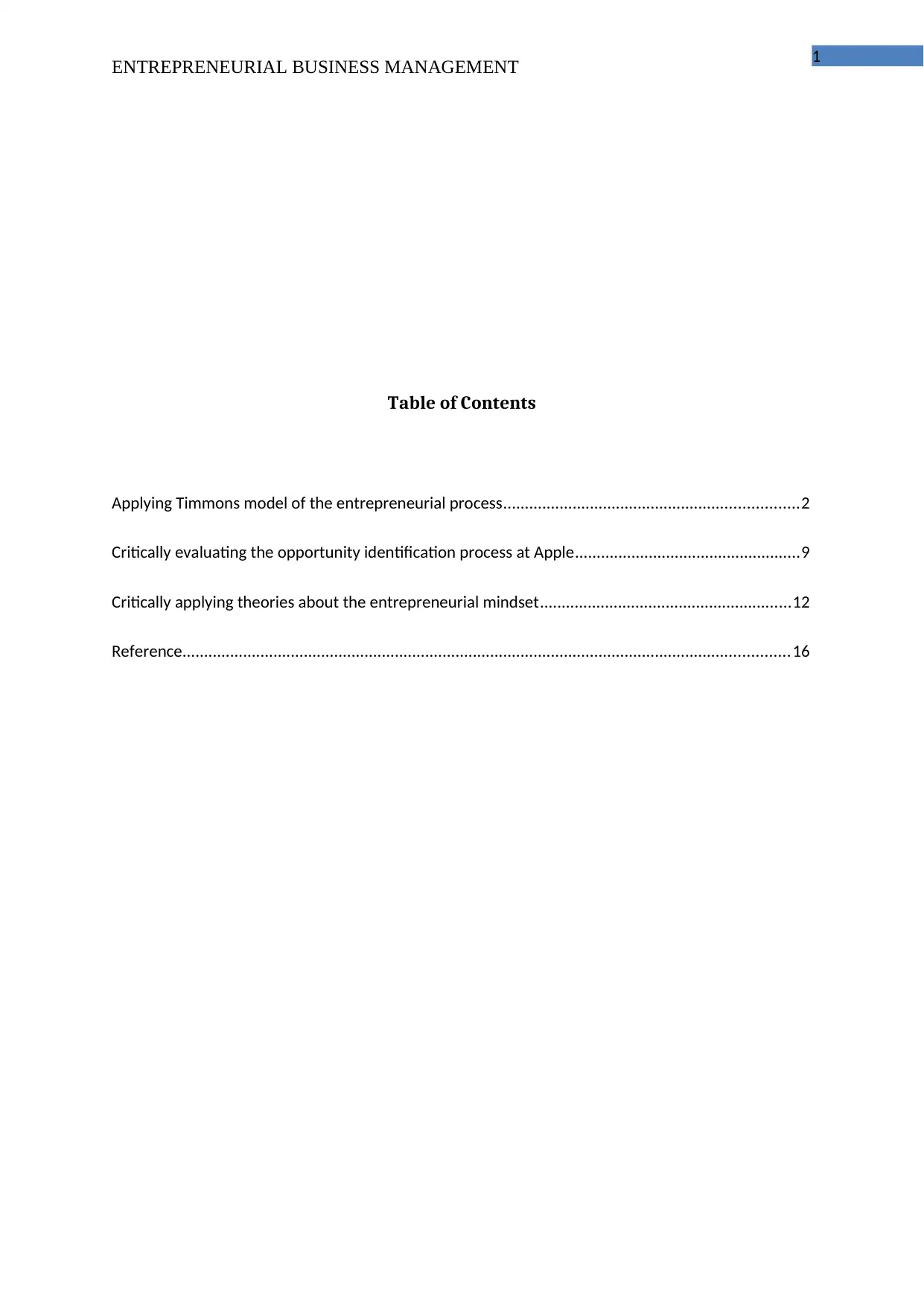
1
ENTREPRENEURIAL BUSINESS MANAGEMENT
Table of Contents
Applying Timmons model of the entrepreneurial process....................................................................2
Critically evaluating the opportunity identification process at Apple....................................................9
Critically applying theories about the entrepreneurial mindset..........................................................12
Reference............................................................................................................................................16
ENTREPRENEURIAL BUSINESS MANAGEMENT
Table of Contents
Applying Timmons model of the entrepreneurial process....................................................................2
Critically evaluating the opportunity identification process at Apple....................................................9
Critically applying theories about the entrepreneurial mindset..........................................................12
Reference............................................................................................................................................16
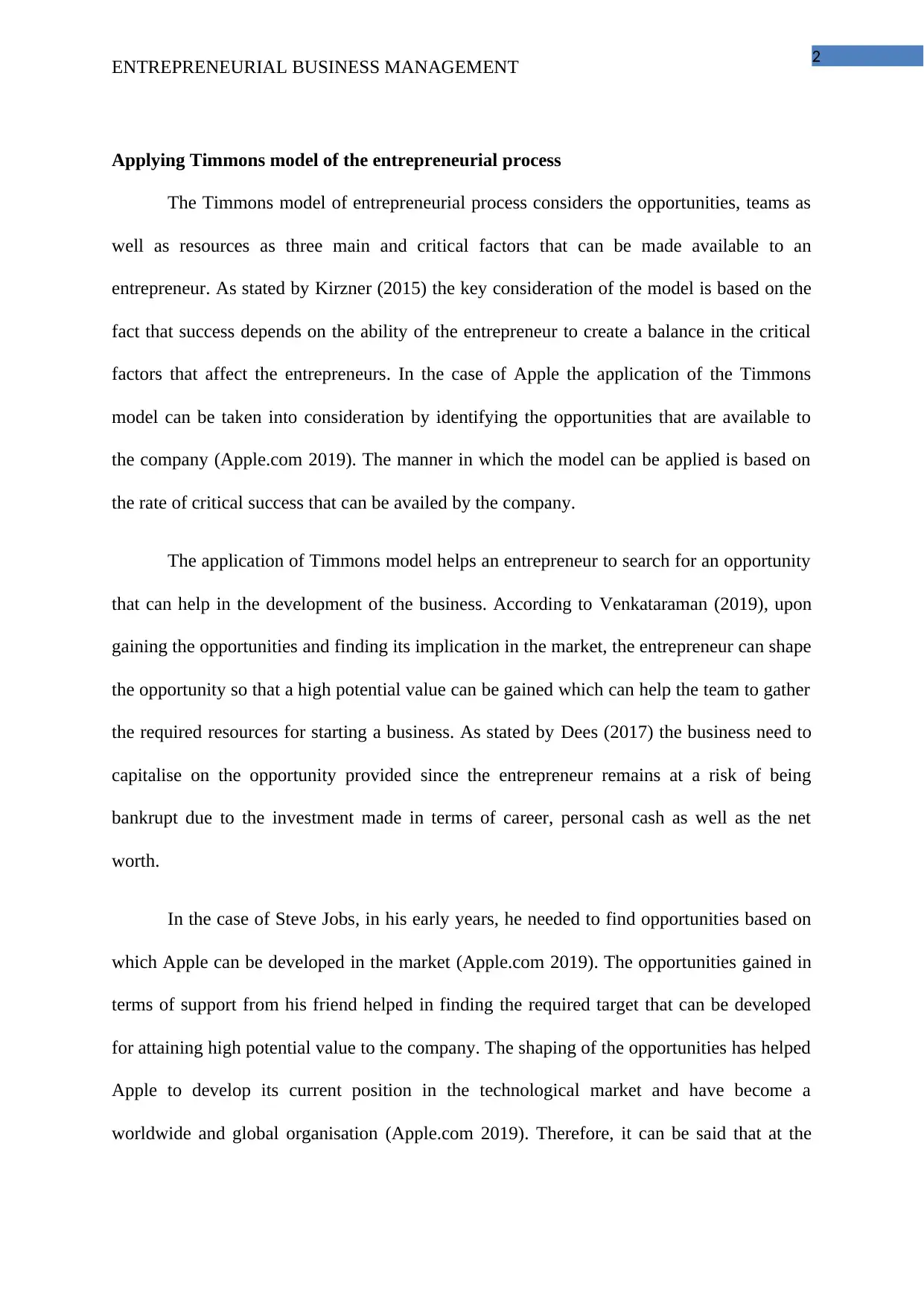
2
ENTREPRENEURIAL BUSINESS MANAGEMENT
Applying Timmons model of the entrepreneurial process
The Timmons model of entrepreneurial process considers the opportunities, teams as
well as resources as three main and critical factors that can be made available to an
entrepreneur. As stated by Kirzner (2015) the key consideration of the model is based on the
fact that success depends on the ability of the entrepreneur to create a balance in the critical
factors that affect the entrepreneurs. In the case of Apple the application of the Timmons
model can be taken into consideration by identifying the opportunities that are available to
the company (Apple.com 2019). The manner in which the model can be applied is based on
the rate of critical success that can be availed by the company.
The application of Timmons model helps an entrepreneur to search for an opportunity
that can help in the development of the business. According to Venkataraman (2019), upon
gaining the opportunities and finding its implication in the market, the entrepreneur can shape
the opportunity so that a high potential value can be gained which can help the team to gather
the required resources for starting a business. As stated by Dees (2017) the business need to
capitalise on the opportunity provided since the entrepreneur remains at a risk of being
bankrupt due to the investment made in terms of career, personal cash as well as the net
worth.
In the case of Steve Jobs, in his early years, he needed to find opportunities based on
which Apple can be developed in the market (Apple.com 2019). The opportunities gained in
terms of support from his friend helped in finding the required target that can be developed
for attaining high potential value to the company. The shaping of the opportunities has helped
Apple to develop its current position in the technological market and have become a
worldwide and global organisation (Apple.com 2019). Therefore, it can be said that at the
ENTREPRENEURIAL BUSINESS MANAGEMENT
Applying Timmons model of the entrepreneurial process
The Timmons model of entrepreneurial process considers the opportunities, teams as
well as resources as three main and critical factors that can be made available to an
entrepreneur. As stated by Kirzner (2015) the key consideration of the model is based on the
fact that success depends on the ability of the entrepreneur to create a balance in the critical
factors that affect the entrepreneurs. In the case of Apple the application of the Timmons
model can be taken into consideration by identifying the opportunities that are available to
the company (Apple.com 2019). The manner in which the model can be applied is based on
the rate of critical success that can be availed by the company.
The application of Timmons model helps an entrepreneur to search for an opportunity
that can help in the development of the business. According to Venkataraman (2019), upon
gaining the opportunities and finding its implication in the market, the entrepreneur can shape
the opportunity so that a high potential value can be gained which can help the team to gather
the required resources for starting a business. As stated by Dees (2017) the business need to
capitalise on the opportunity provided since the entrepreneur remains at a risk of being
bankrupt due to the investment made in terms of career, personal cash as well as the net
worth.
In the case of Steve Jobs, in his early years, he needed to find opportunities based on
which Apple can be developed in the market (Apple.com 2019). The opportunities gained in
terms of support from his friend helped in finding the required target that can be developed
for attaining high potential value to the company. The shaping of the opportunities has helped
Apple to develop its current position in the technological market and have become a
worldwide and global organisation (Apple.com 2019). Therefore, it can be said that at the
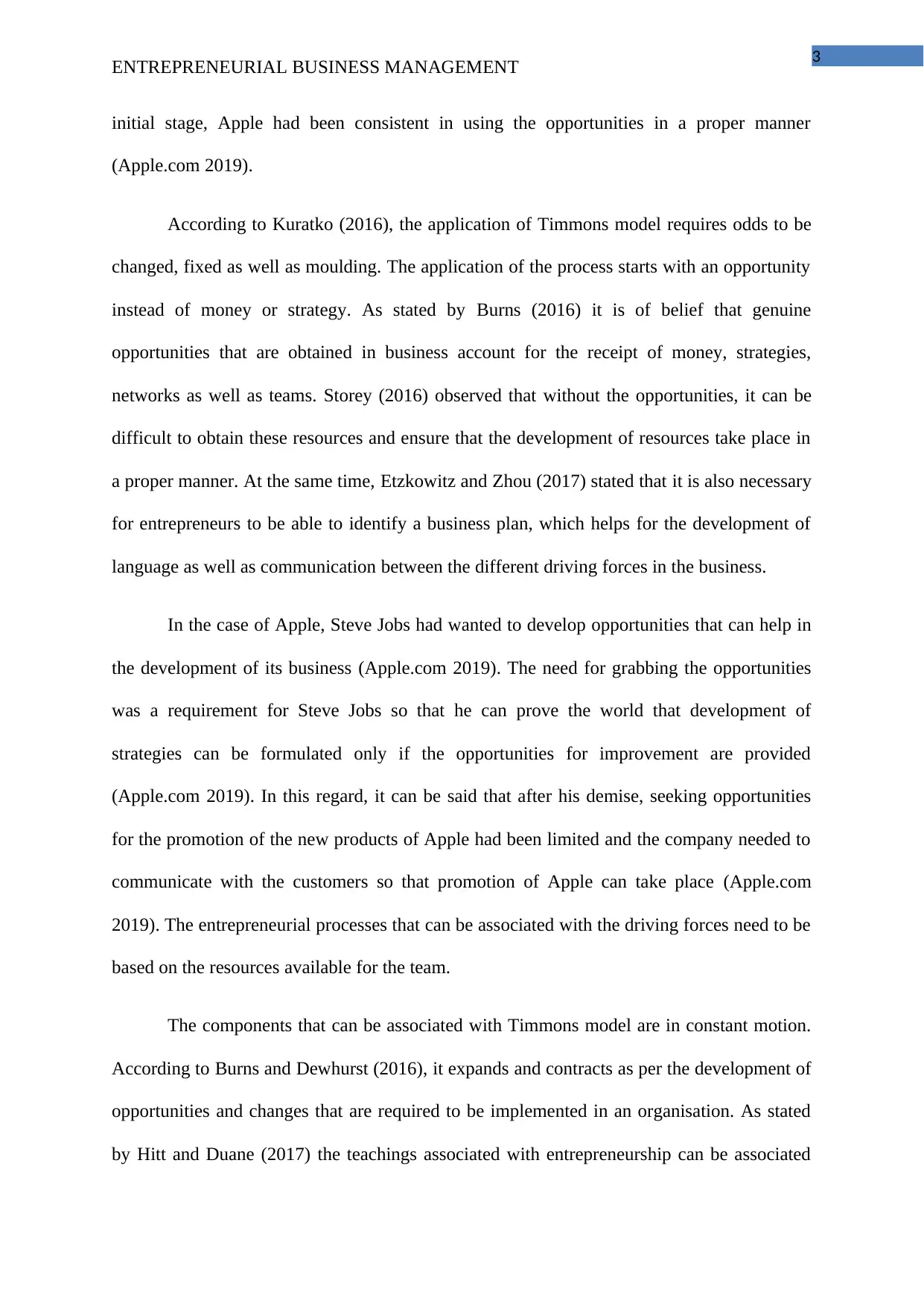
3
ENTREPRENEURIAL BUSINESS MANAGEMENT
initial stage, Apple had been consistent in using the opportunities in a proper manner
(Apple.com 2019).
According to Kuratko (2016), the application of Timmons model requires odds to be
changed, fixed as well as moulding. The application of the process starts with an opportunity
instead of money or strategy. As stated by Burns (2016) it is of belief that genuine
opportunities that are obtained in business account for the receipt of money, strategies,
networks as well as teams. Storey (2016) observed that without the opportunities, it can be
difficult to obtain these resources and ensure that the development of resources take place in
a proper manner. At the same time, Etzkowitz and Zhou (2017) stated that it is also necessary
for entrepreneurs to be able to identify a business plan, which helps for the development of
language as well as communication between the different driving forces in the business.
In the case of Apple, Steve Jobs had wanted to develop opportunities that can help in
the development of its business (Apple.com 2019). The need for grabbing the opportunities
was a requirement for Steve Jobs so that he can prove the world that development of
strategies can be formulated only if the opportunities for improvement are provided
(Apple.com 2019). In this regard, it can be said that after his demise, seeking opportunities
for the promotion of the new products of Apple had been limited and the company needed to
communicate with the customers so that promotion of Apple can take place (Apple.com
2019). The entrepreneurial processes that can be associated with the driving forces need to be
based on the resources available for the team.
The components that can be associated with Timmons model are in constant motion.
According to Burns and Dewhurst (2016), it expands and contracts as per the development of
opportunities and changes that are required to be implemented in an organisation. As stated
by Hitt and Duane (2017) the teachings associated with entrepreneurship can be associated
ENTREPRENEURIAL BUSINESS MANAGEMENT
initial stage, Apple had been consistent in using the opportunities in a proper manner
(Apple.com 2019).
According to Kuratko (2016), the application of Timmons model requires odds to be
changed, fixed as well as moulding. The application of the process starts with an opportunity
instead of money or strategy. As stated by Burns (2016) it is of belief that genuine
opportunities that are obtained in business account for the receipt of money, strategies,
networks as well as teams. Storey (2016) observed that without the opportunities, it can be
difficult to obtain these resources and ensure that the development of resources take place in
a proper manner. At the same time, Etzkowitz and Zhou (2017) stated that it is also necessary
for entrepreneurs to be able to identify a business plan, which helps for the development of
language as well as communication between the different driving forces in the business.
In the case of Apple, Steve Jobs had wanted to develop opportunities that can help in
the development of its business (Apple.com 2019). The need for grabbing the opportunities
was a requirement for Steve Jobs so that he can prove the world that development of
strategies can be formulated only if the opportunities for improvement are provided
(Apple.com 2019). In this regard, it can be said that after his demise, seeking opportunities
for the promotion of the new products of Apple had been limited and the company needed to
communicate with the customers so that promotion of Apple can take place (Apple.com
2019). The entrepreneurial processes that can be associated with the driving forces need to be
based on the resources available for the team.
The components that can be associated with Timmons model are in constant motion.
According to Burns and Dewhurst (2016), it expands and contracts as per the development of
opportunities and changes that are required to be implemented in an organisation. As stated
by Hitt and Duane (2017) the teachings associated with entrepreneurship can be associated
Secure Best Marks with AI Grader
Need help grading? Try our AI Grader for instant feedback on your assignments.
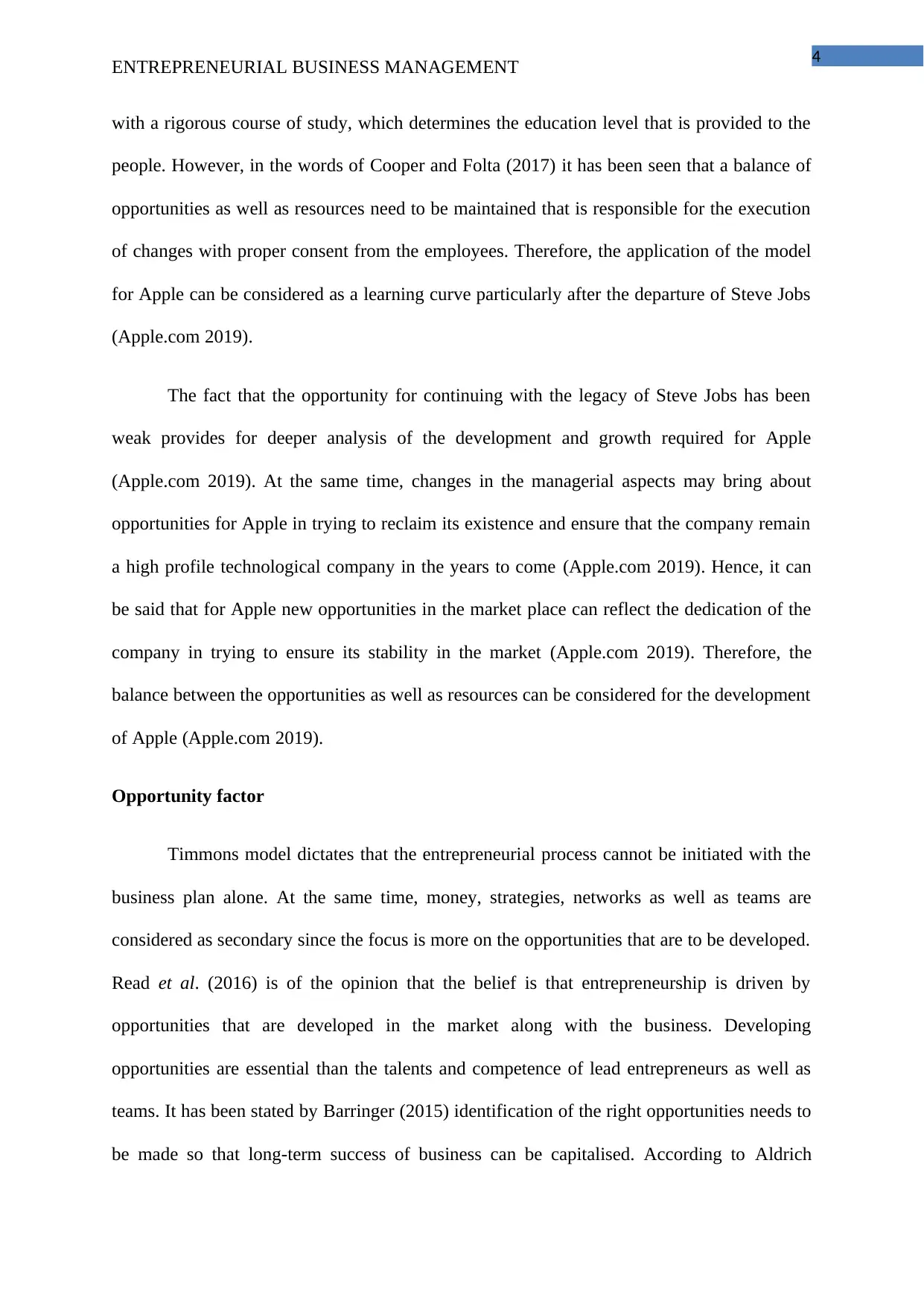
4
ENTREPRENEURIAL BUSINESS MANAGEMENT
with a rigorous course of study, which determines the education level that is provided to the
people. However, in the words of Cooper and Folta (2017) it has been seen that a balance of
opportunities as well as resources need to be maintained that is responsible for the execution
of changes with proper consent from the employees. Therefore, the application of the model
for Apple can be considered as a learning curve particularly after the departure of Steve Jobs
(Apple.com 2019).
The fact that the opportunity for continuing with the legacy of Steve Jobs has been
weak provides for deeper analysis of the development and growth required for Apple
(Apple.com 2019). At the same time, changes in the managerial aspects may bring about
opportunities for Apple in trying to reclaim its existence and ensure that the company remain
a high profile technological company in the years to come (Apple.com 2019). Hence, it can
be said that for Apple new opportunities in the market place can reflect the dedication of the
company in trying to ensure its stability in the market (Apple.com 2019). Therefore, the
balance between the opportunities as well as resources can be considered for the development
of Apple (Apple.com 2019).
Opportunity factor
Timmons model dictates that the entrepreneurial process cannot be initiated with the
business plan alone. At the same time, money, strategies, networks as well as teams are
considered as secondary since the focus is more on the opportunities that are to be developed.
Read et al. (2016) is of the opinion that the belief is that entrepreneurship is driven by
opportunities that are developed in the market along with the business. Developing
opportunities are essential than the talents and competence of lead entrepreneurs as well as
teams. It has been stated by Barringer (2015) identification of the right opportunities needs to
be made so that long-term success of business can be capitalised. According to Aldrich
ENTREPRENEURIAL BUSINESS MANAGEMENT
with a rigorous course of study, which determines the education level that is provided to the
people. However, in the words of Cooper and Folta (2017) it has been seen that a balance of
opportunities as well as resources need to be maintained that is responsible for the execution
of changes with proper consent from the employees. Therefore, the application of the model
for Apple can be considered as a learning curve particularly after the departure of Steve Jobs
(Apple.com 2019).
The fact that the opportunity for continuing with the legacy of Steve Jobs has been
weak provides for deeper analysis of the development and growth required for Apple
(Apple.com 2019). At the same time, changes in the managerial aspects may bring about
opportunities for Apple in trying to reclaim its existence and ensure that the company remain
a high profile technological company in the years to come (Apple.com 2019). Hence, it can
be said that for Apple new opportunities in the market place can reflect the dedication of the
company in trying to ensure its stability in the market (Apple.com 2019). Therefore, the
balance between the opportunities as well as resources can be considered for the development
of Apple (Apple.com 2019).
Opportunity factor
Timmons model dictates that the entrepreneurial process cannot be initiated with the
business plan alone. At the same time, money, strategies, networks as well as teams are
considered as secondary since the focus is more on the opportunities that are to be developed.
Read et al. (2016) is of the opinion that the belief is that entrepreneurship is driven by
opportunities that are developed in the market along with the business. Developing
opportunities are essential than the talents and competence of lead entrepreneurs as well as
teams. It has been stated by Barringer (2015) identification of the right opportunities needs to
be made so that long-term success of business can be capitalised. According to Aldrich
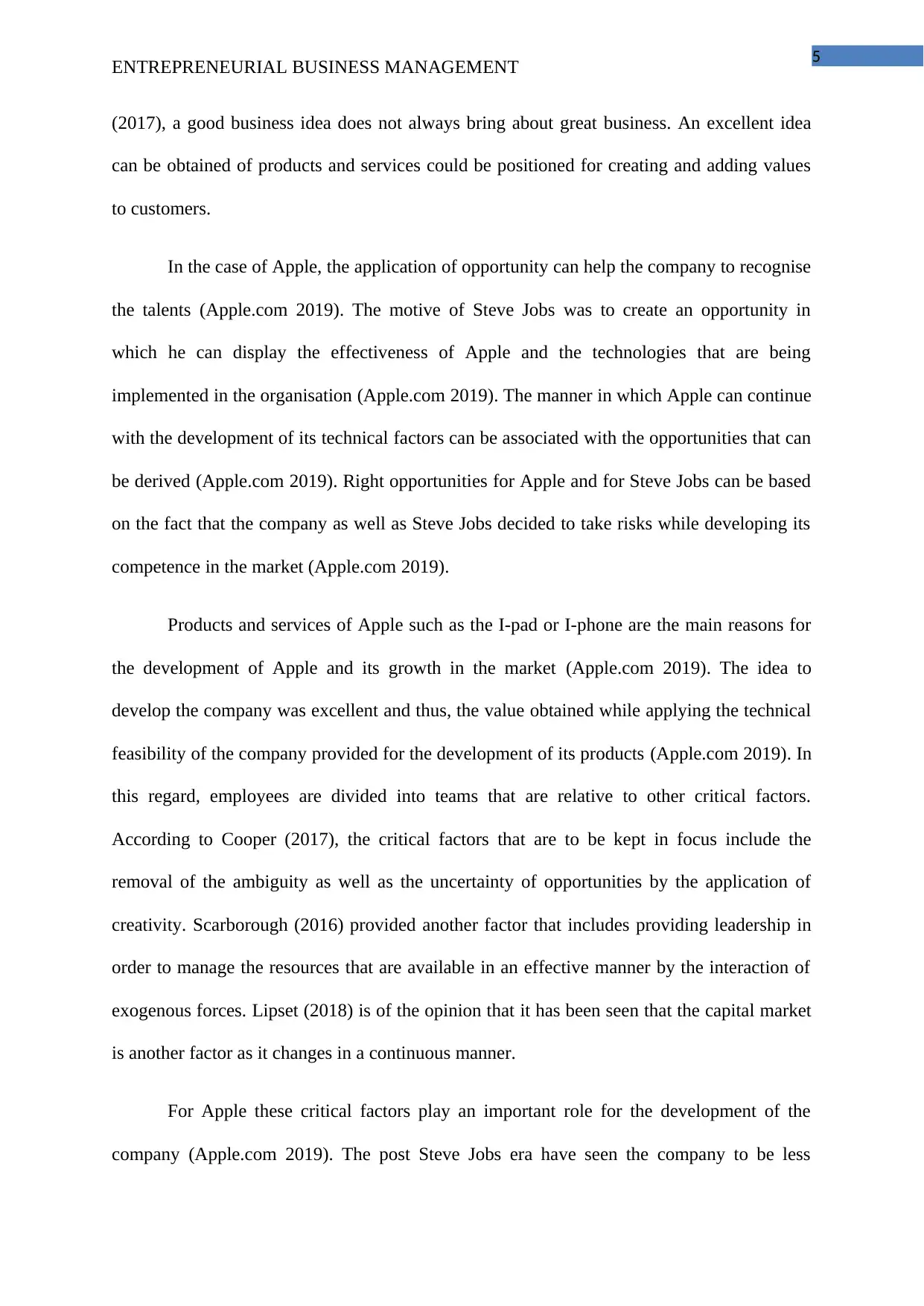
5
ENTREPRENEURIAL BUSINESS MANAGEMENT
(2017), a good business idea does not always bring about great business. An excellent idea
can be obtained of products and services could be positioned for creating and adding values
to customers.
In the case of Apple, the application of opportunity can help the company to recognise
the talents (Apple.com 2019). The motive of Steve Jobs was to create an opportunity in
which he can display the effectiveness of Apple and the technologies that are being
implemented in the organisation (Apple.com 2019). The manner in which Apple can continue
with the development of its technical factors can be associated with the opportunities that can
be derived (Apple.com 2019). Right opportunities for Apple and for Steve Jobs can be based
on the fact that the company as well as Steve Jobs decided to take risks while developing its
competence in the market (Apple.com 2019).
Products and services of Apple such as the I-pad or I-phone are the main reasons for
the development of Apple and its growth in the market (Apple.com 2019). The idea to
develop the company was excellent and thus, the value obtained while applying the technical
feasibility of the company provided for the development of its products (Apple.com 2019). In
this regard, employees are divided into teams that are relative to other critical factors.
According to Cooper (2017), the critical factors that are to be kept in focus include the
removal of the ambiguity as well as the uncertainty of opportunities by the application of
creativity. Scarborough (2016) provided another factor that includes providing leadership in
order to manage the resources that are available in an effective manner by the interaction of
exogenous forces. Lipset (2018) is of the opinion that it has been seen that the capital market
is another factor as it changes in a continuous manner.
For Apple these critical factors play an important role for the development of the
company (Apple.com 2019). The post Steve Jobs era have seen the company to be less
ENTREPRENEURIAL BUSINESS MANAGEMENT
(2017), a good business idea does not always bring about great business. An excellent idea
can be obtained of products and services could be positioned for creating and adding values
to customers.
In the case of Apple, the application of opportunity can help the company to recognise
the talents (Apple.com 2019). The motive of Steve Jobs was to create an opportunity in
which he can display the effectiveness of Apple and the technologies that are being
implemented in the organisation (Apple.com 2019). The manner in which Apple can continue
with the development of its technical factors can be associated with the opportunities that can
be derived (Apple.com 2019). Right opportunities for Apple and for Steve Jobs can be based
on the fact that the company as well as Steve Jobs decided to take risks while developing its
competence in the market (Apple.com 2019).
Products and services of Apple such as the I-pad or I-phone are the main reasons for
the development of Apple and its growth in the market (Apple.com 2019). The idea to
develop the company was excellent and thus, the value obtained while applying the technical
feasibility of the company provided for the development of its products (Apple.com 2019). In
this regard, employees are divided into teams that are relative to other critical factors.
According to Cooper (2017), the critical factors that are to be kept in focus include the
removal of the ambiguity as well as the uncertainty of opportunities by the application of
creativity. Scarborough (2016) provided another factor that includes providing leadership in
order to manage the resources that are available in an effective manner by the interaction of
exogenous forces. Lipset (2018) is of the opinion that it has been seen that the capital market
is another factor as it changes in a continuous manner.
For Apple these critical factors play an important role for the development of the
company (Apple.com 2019). The post Steve Jobs era have seen the company to be less
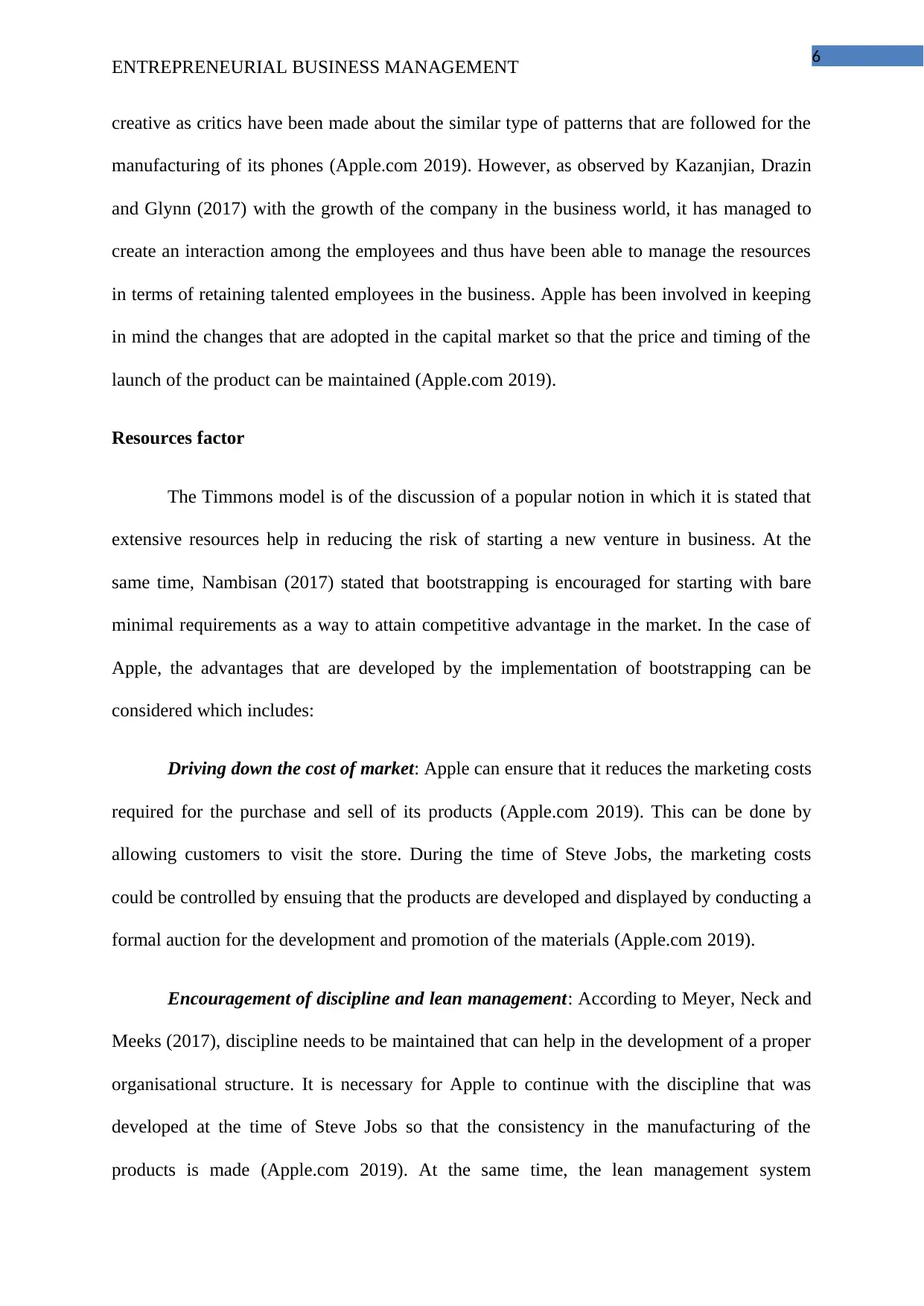
6
ENTREPRENEURIAL BUSINESS MANAGEMENT
creative as critics have been made about the similar type of patterns that are followed for the
manufacturing of its phones (Apple.com 2019). However, as observed by Kazanjian, Drazin
and Glynn (2017) with the growth of the company in the business world, it has managed to
create an interaction among the employees and thus have been able to manage the resources
in terms of retaining talented employees in the business. Apple has been involved in keeping
in mind the changes that are adopted in the capital market so that the price and timing of the
launch of the product can be maintained (Apple.com 2019).
Resources factor
The Timmons model is of the discussion of a popular notion in which it is stated that
extensive resources help in reducing the risk of starting a new venture in business. At the
same time, Nambisan (2017) stated that bootstrapping is encouraged for starting with bare
minimal requirements as a way to attain competitive advantage in the market. In the case of
Apple, the advantages that are developed by the implementation of bootstrapping can be
considered which includes:
Driving down the cost of market: Apple can ensure that it reduces the marketing costs
required for the purchase and sell of its products (Apple.com 2019). This can be done by
allowing customers to visit the store. During the time of Steve Jobs, the marketing costs
could be controlled by ensuing that the products are developed and displayed by conducting a
formal auction for the development and promotion of the materials (Apple.com 2019).
Encouragement of discipline and lean management: According to Meyer, Neck and
Meeks (2017), discipline needs to be maintained that can help in the development of a proper
organisational structure. It is necessary for Apple to continue with the discipline that was
developed at the time of Steve Jobs so that the consistency in the manufacturing of the
products is made (Apple.com 2019). At the same time, the lean management system
ENTREPRENEURIAL BUSINESS MANAGEMENT
creative as critics have been made about the similar type of patterns that are followed for the
manufacturing of its phones (Apple.com 2019). However, as observed by Kazanjian, Drazin
and Glynn (2017) with the growth of the company in the business world, it has managed to
create an interaction among the employees and thus have been able to manage the resources
in terms of retaining talented employees in the business. Apple has been involved in keeping
in mind the changes that are adopted in the capital market so that the price and timing of the
launch of the product can be maintained (Apple.com 2019).
Resources factor
The Timmons model is of the discussion of a popular notion in which it is stated that
extensive resources help in reducing the risk of starting a new venture in business. At the
same time, Nambisan (2017) stated that bootstrapping is encouraged for starting with bare
minimal requirements as a way to attain competitive advantage in the market. In the case of
Apple, the advantages that are developed by the implementation of bootstrapping can be
considered which includes:
Driving down the cost of market: Apple can ensure that it reduces the marketing costs
required for the purchase and sell of its products (Apple.com 2019). This can be done by
allowing customers to visit the store. During the time of Steve Jobs, the marketing costs
could be controlled by ensuing that the products are developed and displayed by conducting a
formal auction for the development and promotion of the materials (Apple.com 2019).
Encouragement of discipline and lean management: According to Meyer, Neck and
Meeks (2017), discipline needs to be maintained that can help in the development of a proper
organisational structure. It is necessary for Apple to continue with the discipline that was
developed at the time of Steve Jobs so that the consistency in the manufacturing of the
products is made (Apple.com 2019). At the same time, the lean management system
Paraphrase This Document
Need a fresh take? Get an instant paraphrase of this document with our AI Paraphraser
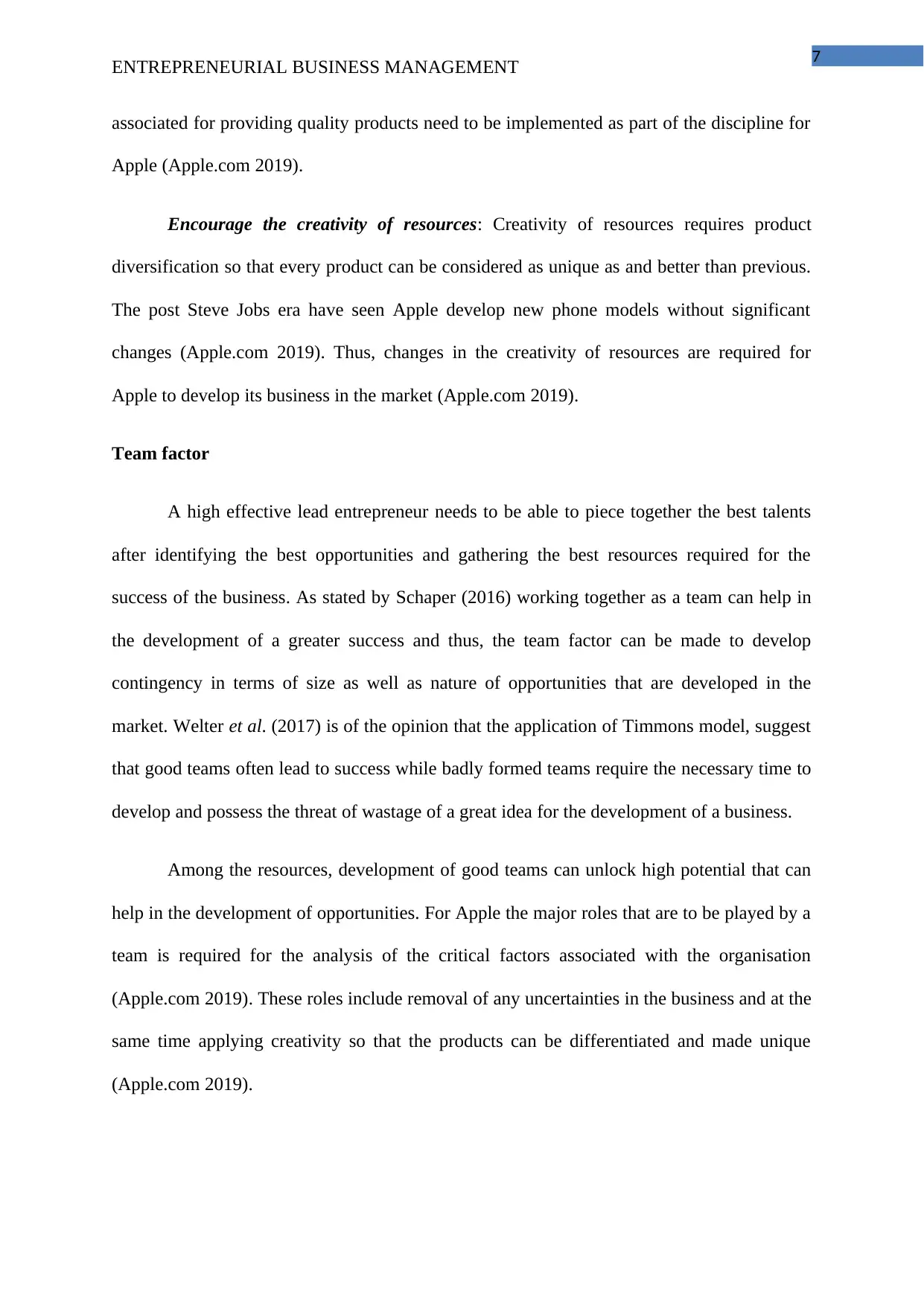
7
ENTREPRENEURIAL BUSINESS MANAGEMENT
associated for providing quality products need to be implemented as part of the discipline for
Apple (Apple.com 2019).
Encourage the creativity of resources: Creativity of resources requires product
diversification so that every product can be considered as unique as and better than previous.
The post Steve Jobs era have seen Apple develop new phone models without significant
changes (Apple.com 2019). Thus, changes in the creativity of resources are required for
Apple to develop its business in the market (Apple.com 2019).
Team factor
A high effective lead entrepreneur needs to be able to piece together the best talents
after identifying the best opportunities and gathering the best resources required for the
success of the business. As stated by Schaper (2016) working together as a team can help in
the development of a greater success and thus, the team factor can be made to develop
contingency in terms of size as well as nature of opportunities that are developed in the
market. Welter et al. (2017) is of the opinion that the application of Timmons model, suggest
that good teams often lead to success while badly formed teams require the necessary time to
develop and possess the threat of wastage of a great idea for the development of a business.
Among the resources, development of good teams can unlock high potential that can
help in the development of opportunities. For Apple the major roles that are to be played by a
team is required for the analysis of the critical factors associated with the organisation
(Apple.com 2019). These roles include removal of any uncertainties in the business and at the
same time applying creativity so that the products can be differentiated and made unique
(Apple.com 2019).
ENTREPRENEURIAL BUSINESS MANAGEMENT
associated for providing quality products need to be implemented as part of the discipline for
Apple (Apple.com 2019).
Encourage the creativity of resources: Creativity of resources requires product
diversification so that every product can be considered as unique as and better than previous.
The post Steve Jobs era have seen Apple develop new phone models without significant
changes (Apple.com 2019). Thus, changes in the creativity of resources are required for
Apple to develop its business in the market (Apple.com 2019).
Team factor
A high effective lead entrepreneur needs to be able to piece together the best talents
after identifying the best opportunities and gathering the best resources required for the
success of the business. As stated by Schaper (2016) working together as a team can help in
the development of a greater success and thus, the team factor can be made to develop
contingency in terms of size as well as nature of opportunities that are developed in the
market. Welter et al. (2017) is of the opinion that the application of Timmons model, suggest
that good teams often lead to success while badly formed teams require the necessary time to
develop and possess the threat of wastage of a great idea for the development of a business.
Among the resources, development of good teams can unlock high potential that can
help in the development of opportunities. For Apple the major roles that are to be played by a
team is required for the analysis of the critical factors associated with the organisation
(Apple.com 2019). These roles include removal of any uncertainties in the business and at the
same time applying creativity so that the products can be differentiated and made unique
(Apple.com 2019).
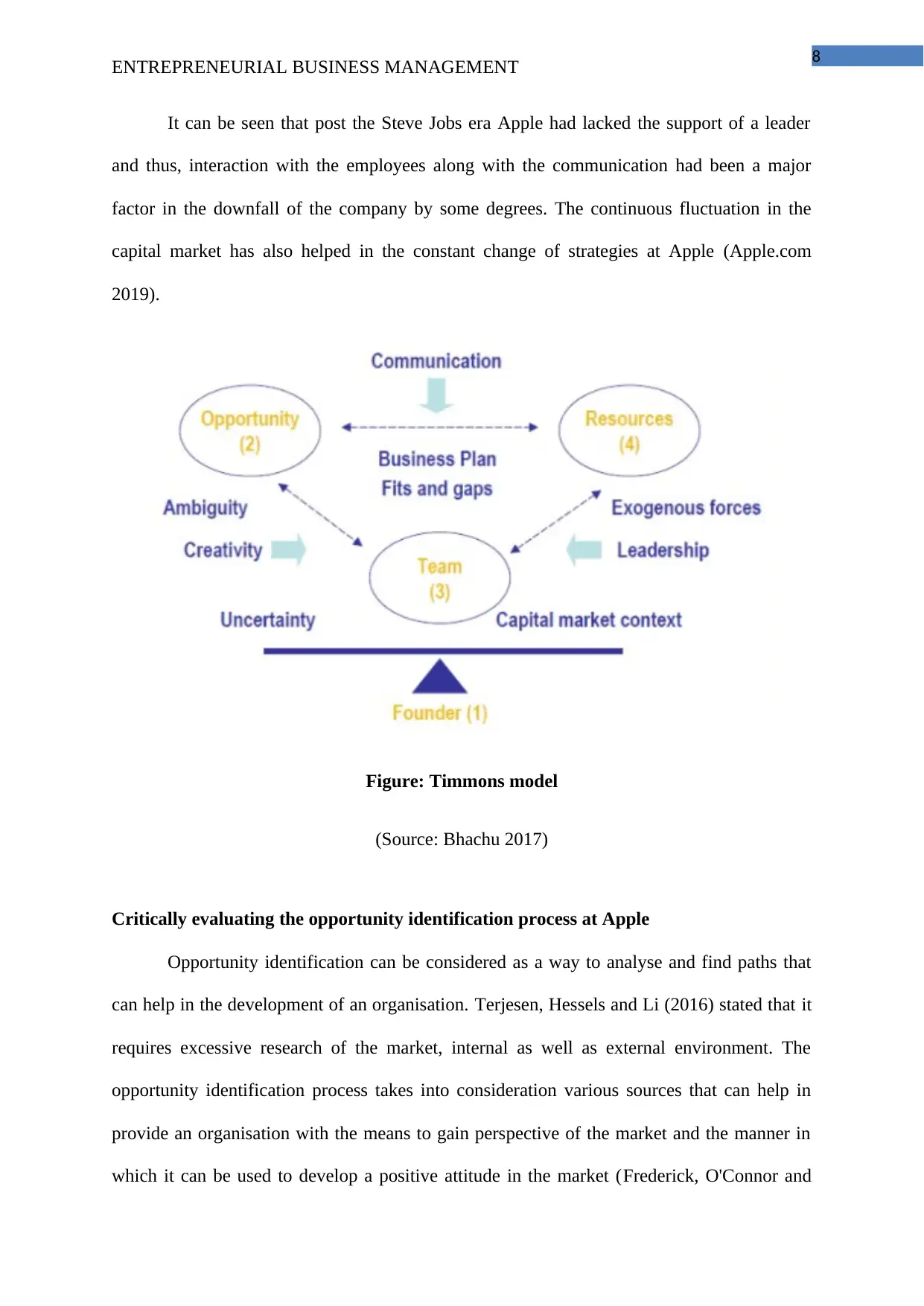
8
ENTREPRENEURIAL BUSINESS MANAGEMENT
It can be seen that post the Steve Jobs era Apple had lacked the support of a leader
and thus, interaction with the employees along with the communication had been a major
factor in the downfall of the company by some degrees. The continuous fluctuation in the
capital market has also helped in the constant change of strategies at Apple (Apple.com
2019).
Figure: Timmons model
(Source: Bhachu 2017)
Critically evaluating the opportunity identification process at Apple
Opportunity identification can be considered as a way to analyse and find paths that
can help in the development of an organisation. Terjesen, Hessels and Li (2016) stated that it
requires excessive research of the market, internal as well as external environment. The
opportunity identification process takes into consideration various sources that can help in
provide an organisation with the means to gain perspective of the market and the manner in
which it can be used to develop a positive attitude in the market (Frederick, O'Connor and
ENTREPRENEURIAL BUSINESS MANAGEMENT
It can be seen that post the Steve Jobs era Apple had lacked the support of a leader
and thus, interaction with the employees along with the communication had been a major
factor in the downfall of the company by some degrees. The continuous fluctuation in the
capital market has also helped in the constant change of strategies at Apple (Apple.com
2019).
Figure: Timmons model
(Source: Bhachu 2017)
Critically evaluating the opportunity identification process at Apple
Opportunity identification can be considered as a way to analyse and find paths that
can help in the development of an organisation. Terjesen, Hessels and Li (2016) stated that it
requires excessive research of the market, internal as well as external environment. The
opportunity identification process takes into consideration various sources that can help in
provide an organisation with the means to gain perspective of the market and the manner in
which it can be used to develop a positive attitude in the market (Frederick, O'Connor and
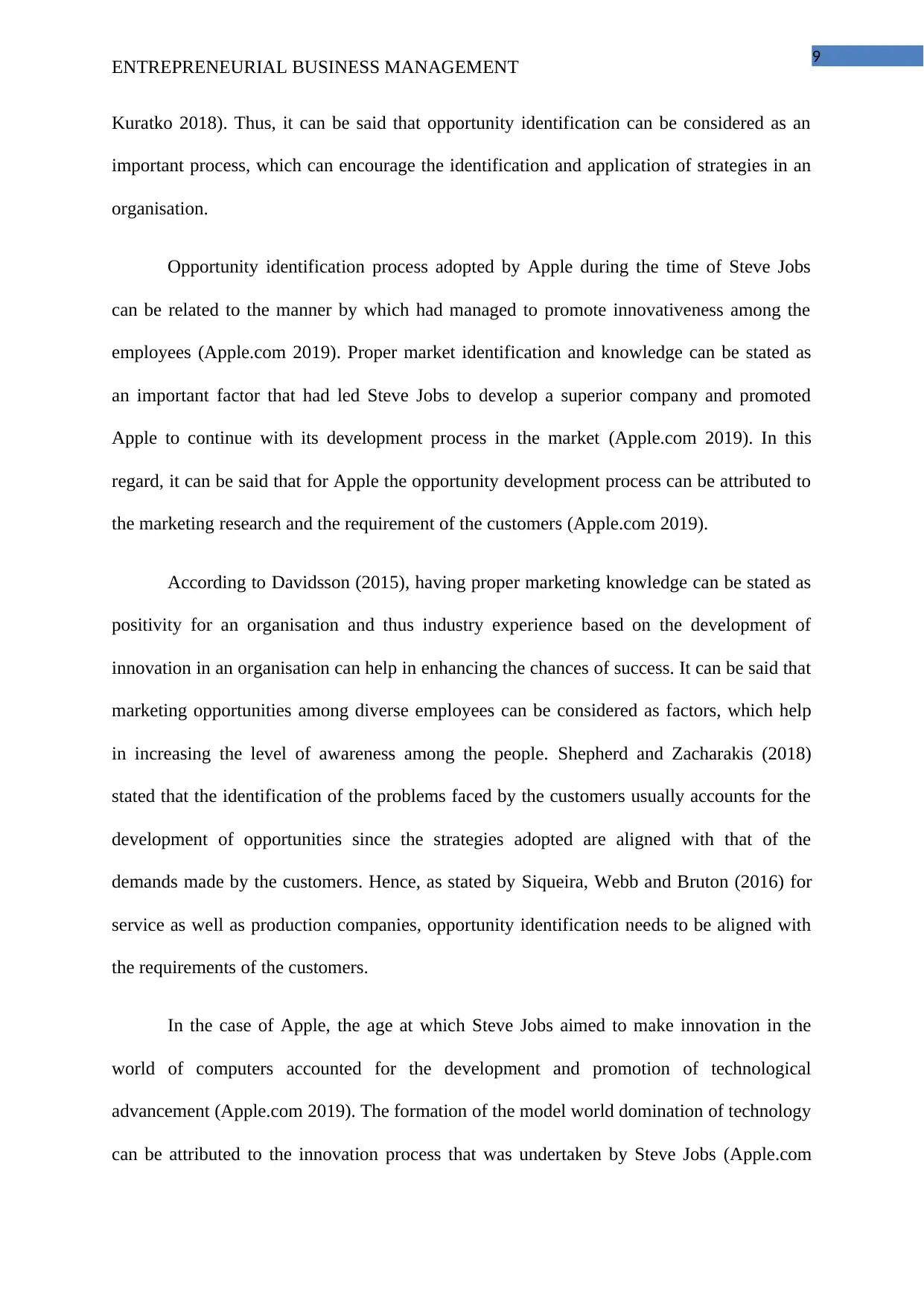
9
ENTREPRENEURIAL BUSINESS MANAGEMENT
Kuratko 2018). Thus, it can be said that opportunity identification can be considered as an
important process, which can encourage the identification and application of strategies in an
organisation.
Opportunity identification process adopted by Apple during the time of Steve Jobs
can be related to the manner by which had managed to promote innovativeness among the
employees (Apple.com 2019). Proper market identification and knowledge can be stated as
an important factor that had led Steve Jobs to develop a superior company and promoted
Apple to continue with its development process in the market (Apple.com 2019). In this
regard, it can be said that for Apple the opportunity development process can be attributed to
the marketing research and the requirement of the customers (Apple.com 2019).
According to Davidsson (2015), having proper marketing knowledge can be stated as
positivity for an organisation and thus industry experience based on the development of
innovation in an organisation can help in enhancing the chances of success. It can be said that
marketing opportunities among diverse employees can be considered as factors, which help
in increasing the level of awareness among the people. Shepherd and Zacharakis (2018)
stated that the identification of the problems faced by the customers usually accounts for the
development of opportunities since the strategies adopted are aligned with that of the
demands made by the customers. Hence, as stated by Siqueira, Webb and Bruton (2016) for
service as well as production companies, opportunity identification needs to be aligned with
the requirements of the customers.
In the case of Apple, the age at which Steve Jobs aimed to make innovation in the
world of computers accounted for the development and promotion of technological
advancement (Apple.com 2019). The formation of the model world domination of technology
can be attributed to the innovation process that was undertaken by Steve Jobs (Apple.com
ENTREPRENEURIAL BUSINESS MANAGEMENT
Kuratko 2018). Thus, it can be said that opportunity identification can be considered as an
important process, which can encourage the identification and application of strategies in an
organisation.
Opportunity identification process adopted by Apple during the time of Steve Jobs
can be related to the manner by which had managed to promote innovativeness among the
employees (Apple.com 2019). Proper market identification and knowledge can be stated as
an important factor that had led Steve Jobs to develop a superior company and promoted
Apple to continue with its development process in the market (Apple.com 2019). In this
regard, it can be said that for Apple the opportunity development process can be attributed to
the marketing research and the requirement of the customers (Apple.com 2019).
According to Davidsson (2015), having proper marketing knowledge can be stated as
positivity for an organisation and thus industry experience based on the development of
innovation in an organisation can help in enhancing the chances of success. It can be said that
marketing opportunities among diverse employees can be considered as factors, which help
in increasing the level of awareness among the people. Shepherd and Zacharakis (2018)
stated that the identification of the problems faced by the customers usually accounts for the
development of opportunities since the strategies adopted are aligned with that of the
demands made by the customers. Hence, as stated by Siqueira, Webb and Bruton (2016) for
service as well as production companies, opportunity identification needs to be aligned with
the requirements of the customers.
In the case of Apple, the age at which Steve Jobs aimed to make innovation in the
world of computers accounted for the development and promotion of technological
advancement (Apple.com 2019). The formation of the model world domination of technology
can be attributed to the innovation process that was undertaken by Steve Jobs (Apple.com
Secure Best Marks with AI Grader
Need help grading? Try our AI Grader for instant feedback on your assignments.
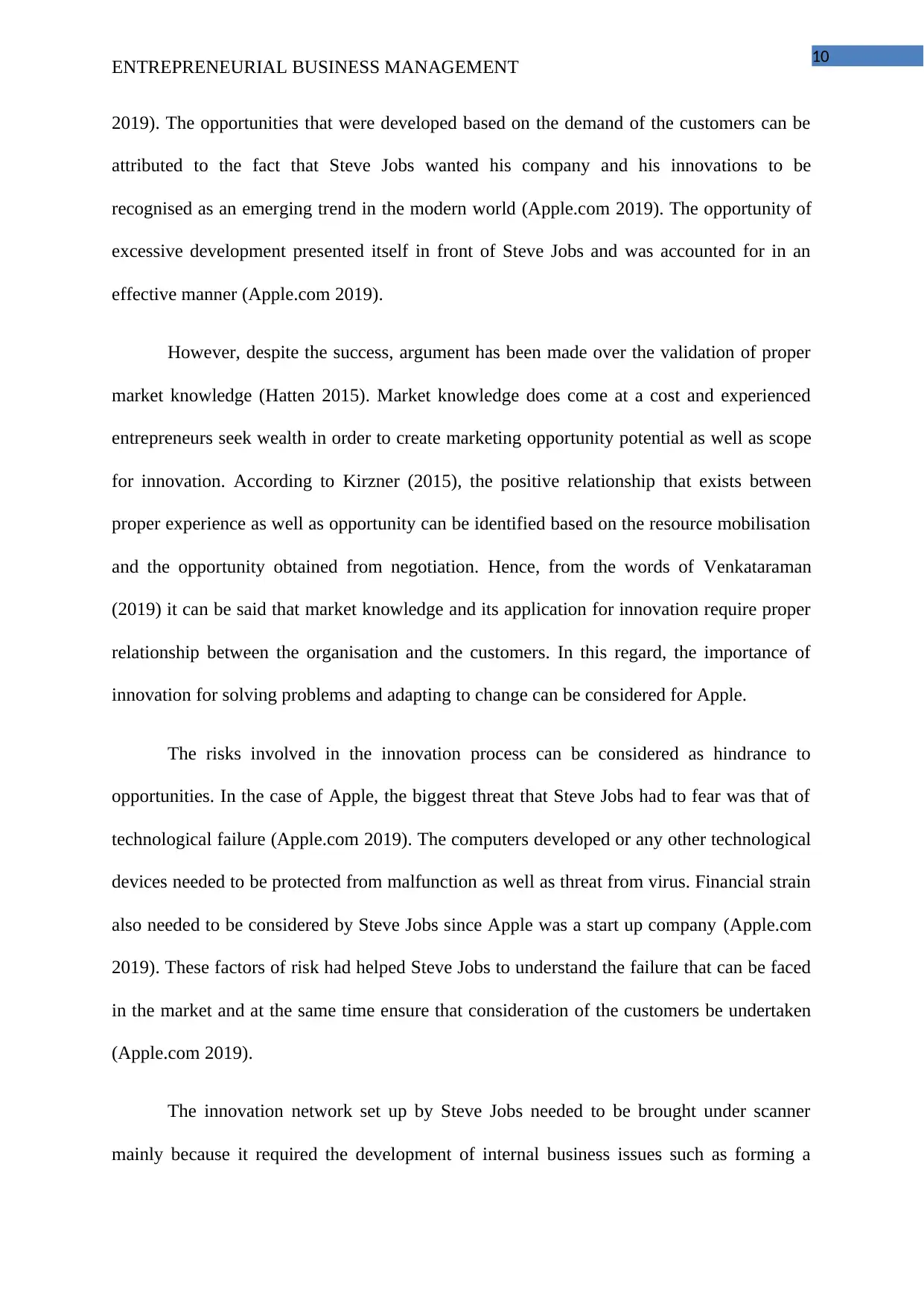
10
ENTREPRENEURIAL BUSINESS MANAGEMENT
2019). The opportunities that were developed based on the demand of the customers can be
attributed to the fact that Steve Jobs wanted his company and his innovations to be
recognised as an emerging trend in the modern world (Apple.com 2019). The opportunity of
excessive development presented itself in front of Steve Jobs and was accounted for in an
effective manner (Apple.com 2019).
However, despite the success, argument has been made over the validation of proper
market knowledge (Hatten 2015). Market knowledge does come at a cost and experienced
entrepreneurs seek wealth in order to create marketing opportunity potential as well as scope
for innovation. According to Kirzner (2015), the positive relationship that exists between
proper experience as well as opportunity can be identified based on the resource mobilisation
and the opportunity obtained from negotiation. Hence, from the words of Venkataraman
(2019) it can be said that market knowledge and its application for innovation require proper
relationship between the organisation and the customers. In this regard, the importance of
innovation for solving problems and adapting to change can be considered for Apple.
The risks involved in the innovation process can be considered as hindrance to
opportunities. In the case of Apple, the biggest threat that Steve Jobs had to fear was that of
technological failure (Apple.com 2019). The computers developed or any other technological
devices needed to be protected from malfunction as well as threat from virus. Financial strain
also needed to be considered by Steve Jobs since Apple was a start up company (Apple.com
2019). These factors of risk had helped Steve Jobs to understand the failure that can be faced
in the market and at the same time ensure that consideration of the customers be undertaken
(Apple.com 2019).
The innovation network set up by Steve Jobs needed to be brought under scanner
mainly because it required the development of internal business issues such as forming a
ENTREPRENEURIAL BUSINESS MANAGEMENT
2019). The opportunities that were developed based on the demand of the customers can be
attributed to the fact that Steve Jobs wanted his company and his innovations to be
recognised as an emerging trend in the modern world (Apple.com 2019). The opportunity of
excessive development presented itself in front of Steve Jobs and was accounted for in an
effective manner (Apple.com 2019).
However, despite the success, argument has been made over the validation of proper
market knowledge (Hatten 2015). Market knowledge does come at a cost and experienced
entrepreneurs seek wealth in order to create marketing opportunity potential as well as scope
for innovation. According to Kirzner (2015), the positive relationship that exists between
proper experience as well as opportunity can be identified based on the resource mobilisation
and the opportunity obtained from negotiation. Hence, from the words of Venkataraman
(2019) it can be said that market knowledge and its application for innovation require proper
relationship between the organisation and the customers. In this regard, the importance of
innovation for solving problems and adapting to change can be considered for Apple.
The risks involved in the innovation process can be considered as hindrance to
opportunities. In the case of Apple, the biggest threat that Steve Jobs had to fear was that of
technological failure (Apple.com 2019). The computers developed or any other technological
devices needed to be protected from malfunction as well as threat from virus. Financial strain
also needed to be considered by Steve Jobs since Apple was a start up company (Apple.com
2019). These factors of risk had helped Steve Jobs to understand the failure that can be faced
in the market and at the same time ensure that consideration of the customers be undertaken
(Apple.com 2019).
The innovation network set up by Steve Jobs needed to be brought under scanner
mainly because it required the development of internal business issues such as forming a
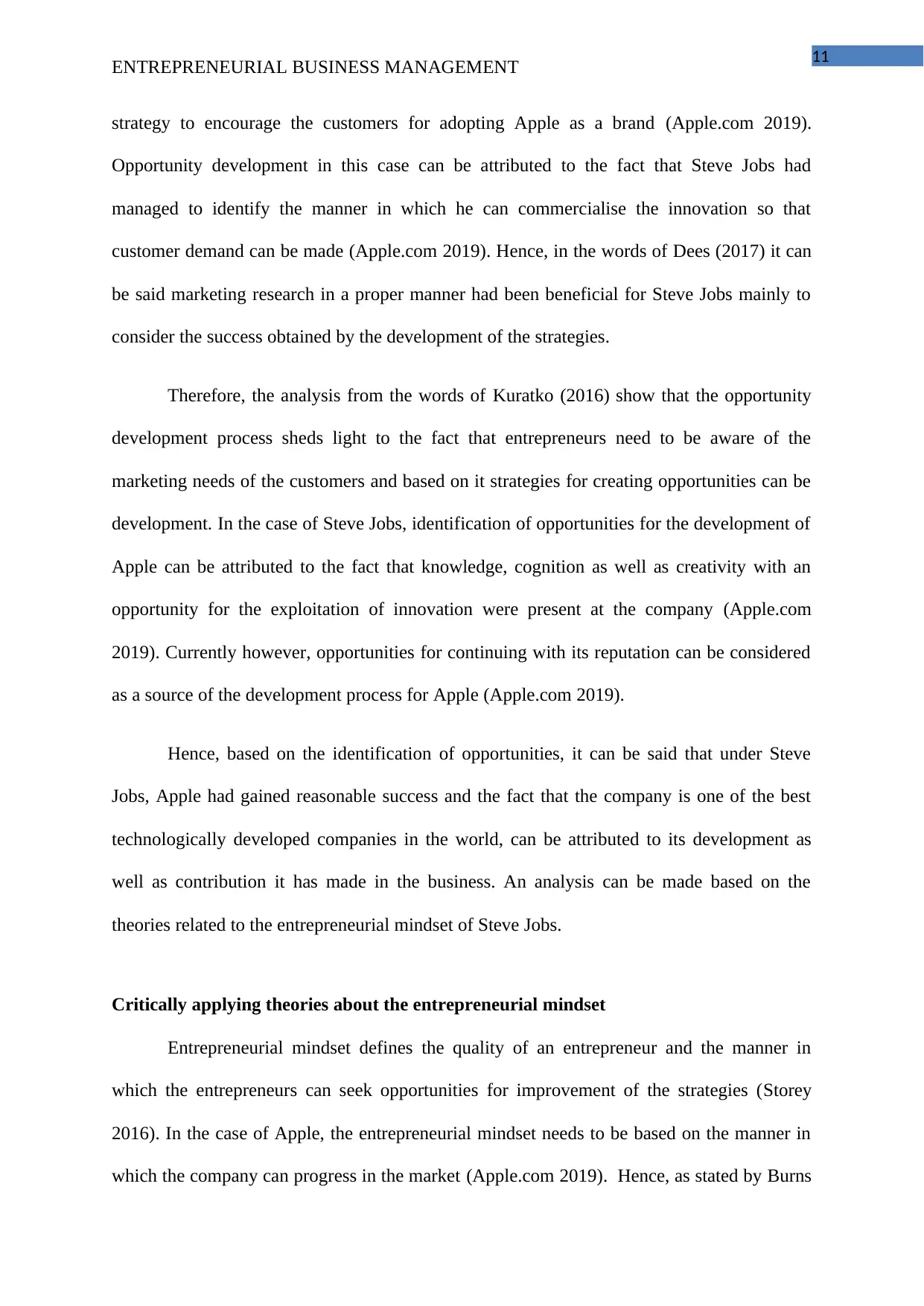
11
ENTREPRENEURIAL BUSINESS MANAGEMENT
strategy to encourage the customers for adopting Apple as a brand (Apple.com 2019).
Opportunity development in this case can be attributed to the fact that Steve Jobs had
managed to identify the manner in which he can commercialise the innovation so that
customer demand can be made (Apple.com 2019). Hence, in the words of Dees (2017) it can
be said marketing research in a proper manner had been beneficial for Steve Jobs mainly to
consider the success obtained by the development of the strategies.
Therefore, the analysis from the words of Kuratko (2016) show that the opportunity
development process sheds light to the fact that entrepreneurs need to be aware of the
marketing needs of the customers and based on it strategies for creating opportunities can be
development. In the case of Steve Jobs, identification of opportunities for the development of
Apple can be attributed to the fact that knowledge, cognition as well as creativity with an
opportunity for the exploitation of innovation were present at the company (Apple.com
2019). Currently however, opportunities for continuing with its reputation can be considered
as a source of the development process for Apple (Apple.com 2019).
Hence, based on the identification of opportunities, it can be said that under Steve
Jobs, Apple had gained reasonable success and the fact that the company is one of the best
technologically developed companies in the world, can be attributed to its development as
well as contribution it has made in the business. An analysis can be made based on the
theories related to the entrepreneurial mindset of Steve Jobs.
Critically applying theories about the entrepreneurial mindset
Entrepreneurial mindset defines the quality of an entrepreneur and the manner in
which the entrepreneurs can seek opportunities for improvement of the strategies (Storey
2016). In the case of Apple, the entrepreneurial mindset needs to be based on the manner in
which the company can progress in the market (Apple.com 2019). Hence, as stated by Burns
ENTREPRENEURIAL BUSINESS MANAGEMENT
strategy to encourage the customers for adopting Apple as a brand (Apple.com 2019).
Opportunity development in this case can be attributed to the fact that Steve Jobs had
managed to identify the manner in which he can commercialise the innovation so that
customer demand can be made (Apple.com 2019). Hence, in the words of Dees (2017) it can
be said marketing research in a proper manner had been beneficial for Steve Jobs mainly to
consider the success obtained by the development of the strategies.
Therefore, the analysis from the words of Kuratko (2016) show that the opportunity
development process sheds light to the fact that entrepreneurs need to be aware of the
marketing needs of the customers and based on it strategies for creating opportunities can be
development. In the case of Steve Jobs, identification of opportunities for the development of
Apple can be attributed to the fact that knowledge, cognition as well as creativity with an
opportunity for the exploitation of innovation were present at the company (Apple.com
2019). Currently however, opportunities for continuing with its reputation can be considered
as a source of the development process for Apple (Apple.com 2019).
Hence, based on the identification of opportunities, it can be said that under Steve
Jobs, Apple had gained reasonable success and the fact that the company is one of the best
technologically developed companies in the world, can be attributed to its development as
well as contribution it has made in the business. An analysis can be made based on the
theories related to the entrepreneurial mindset of Steve Jobs.
Critically applying theories about the entrepreneurial mindset
Entrepreneurial mindset defines the quality of an entrepreneur and the manner in
which the entrepreneurs can seek opportunities for improvement of the strategies (Storey
2016). In the case of Apple, the entrepreneurial mindset needs to be based on the manner in
which the company can progress in the market (Apple.com 2019). Hence, as stated by Burns
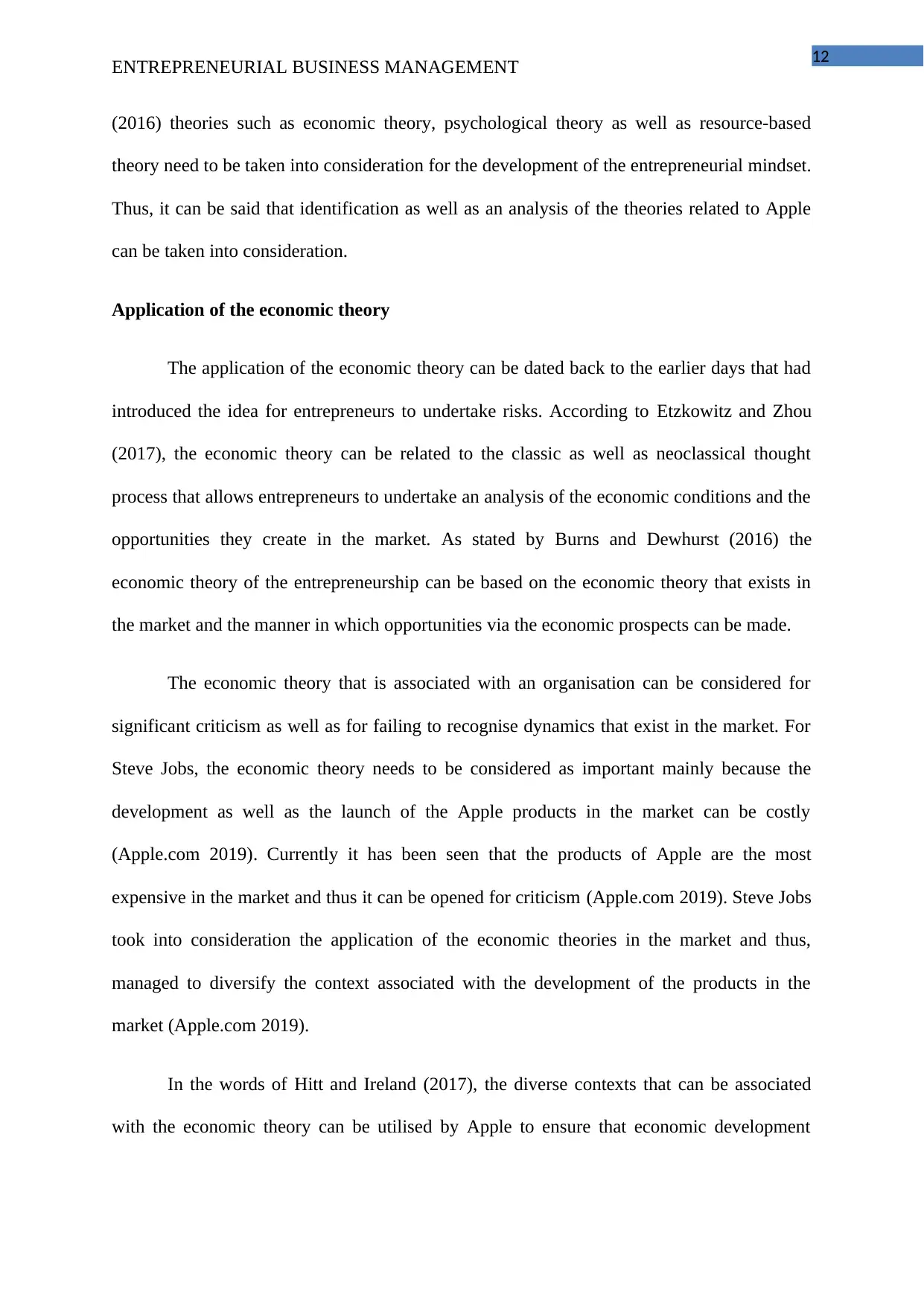
12
ENTREPRENEURIAL BUSINESS MANAGEMENT
(2016) theories such as economic theory, psychological theory as well as resource-based
theory need to be taken into consideration for the development of the entrepreneurial mindset.
Thus, it can be said that identification as well as an analysis of the theories related to Apple
can be taken into consideration.
Application of the economic theory
The application of the economic theory can be dated back to the earlier days that had
introduced the idea for entrepreneurs to undertake risks. According to Etzkowitz and Zhou
(2017), the economic theory can be related to the classic as well as neoclassical thought
process that allows entrepreneurs to undertake an analysis of the economic conditions and the
opportunities they create in the market. As stated by Burns and Dewhurst (2016) the
economic theory of the entrepreneurship can be based on the economic theory that exists in
the market and the manner in which opportunities via the economic prospects can be made.
The economic theory that is associated with an organisation can be considered for
significant criticism as well as for failing to recognise dynamics that exist in the market. For
Steve Jobs, the economic theory needs to be considered as important mainly because the
development as well as the launch of the Apple products in the market can be costly
(Apple.com 2019). Currently it has been seen that the products of Apple are the most
expensive in the market and thus it can be opened for criticism (Apple.com 2019). Steve Jobs
took into consideration the application of the economic theories in the market and thus,
managed to diversify the context associated with the development of the products in the
market (Apple.com 2019).
In the words of Hitt and Ireland (2017), the diverse contexts that can be associated
with the economic theory can be utilised by Apple to ensure that economic development
ENTREPRENEURIAL BUSINESS MANAGEMENT
(2016) theories such as economic theory, psychological theory as well as resource-based
theory need to be taken into consideration for the development of the entrepreneurial mindset.
Thus, it can be said that identification as well as an analysis of the theories related to Apple
can be taken into consideration.
Application of the economic theory
The application of the economic theory can be dated back to the earlier days that had
introduced the idea for entrepreneurs to undertake risks. According to Etzkowitz and Zhou
(2017), the economic theory can be related to the classic as well as neoclassical thought
process that allows entrepreneurs to undertake an analysis of the economic conditions and the
opportunities they create in the market. As stated by Burns and Dewhurst (2016) the
economic theory of the entrepreneurship can be based on the economic theory that exists in
the market and the manner in which opportunities via the economic prospects can be made.
The economic theory that is associated with an organisation can be considered for
significant criticism as well as for failing to recognise dynamics that exist in the market. For
Steve Jobs, the economic theory needs to be considered as important mainly because the
development as well as the launch of the Apple products in the market can be costly
(Apple.com 2019). Currently it has been seen that the products of Apple are the most
expensive in the market and thus it can be opened for criticism (Apple.com 2019). Steve Jobs
took into consideration the application of the economic theories in the market and thus,
managed to diversify the context associated with the development of the products in the
market (Apple.com 2019).
In the words of Hitt and Ireland (2017), the diverse contexts that can be associated
with the economic theory can be utilised by Apple to ensure that economic development
Paraphrase This Document
Need a fresh take? Get an instant paraphrase of this document with our AI Paraphraser
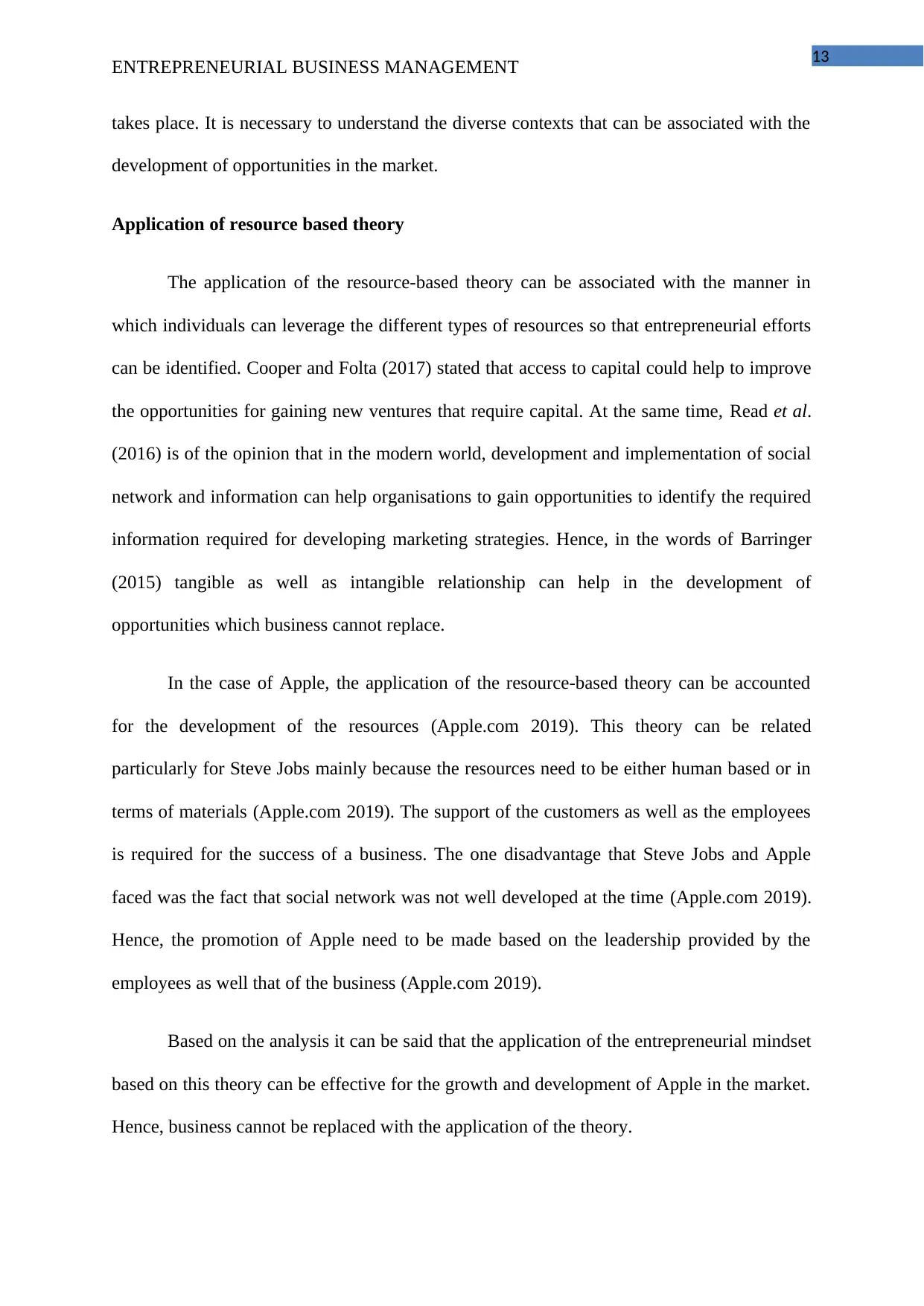
13
ENTREPRENEURIAL BUSINESS MANAGEMENT
takes place. It is necessary to understand the diverse contexts that can be associated with the
development of opportunities in the market.
Application of resource based theory
The application of the resource-based theory can be associated with the manner in
which individuals can leverage the different types of resources so that entrepreneurial efforts
can be identified. Cooper and Folta (2017) stated that access to capital could help to improve
the opportunities for gaining new ventures that require capital. At the same time, Read et al.
(2016) is of the opinion that in the modern world, development and implementation of social
network and information can help organisations to gain opportunities to identify the required
information required for developing marketing strategies. Hence, in the words of Barringer
(2015) tangible as well as intangible relationship can help in the development of
opportunities which business cannot replace.
In the case of Apple, the application of the resource-based theory can be accounted
for the development of the resources (Apple.com 2019). This theory can be related
particularly for Steve Jobs mainly because the resources need to be either human based or in
terms of materials (Apple.com 2019). The support of the customers as well as the employees
is required for the success of a business. The one disadvantage that Steve Jobs and Apple
faced was the fact that social network was not well developed at the time (Apple.com 2019).
Hence, the promotion of Apple need to be made based on the leadership provided by the
employees as well that of the business (Apple.com 2019).
Based on the analysis it can be said that the application of the entrepreneurial mindset
based on this theory can be effective for the growth and development of Apple in the market.
Hence, business cannot be replaced with the application of the theory.
ENTREPRENEURIAL BUSINESS MANAGEMENT
takes place. It is necessary to understand the diverse contexts that can be associated with the
development of opportunities in the market.
Application of resource based theory
The application of the resource-based theory can be associated with the manner in
which individuals can leverage the different types of resources so that entrepreneurial efforts
can be identified. Cooper and Folta (2017) stated that access to capital could help to improve
the opportunities for gaining new ventures that require capital. At the same time, Read et al.
(2016) is of the opinion that in the modern world, development and implementation of social
network and information can help organisations to gain opportunities to identify the required
information required for developing marketing strategies. Hence, in the words of Barringer
(2015) tangible as well as intangible relationship can help in the development of
opportunities which business cannot replace.
In the case of Apple, the application of the resource-based theory can be accounted
for the development of the resources (Apple.com 2019). This theory can be related
particularly for Steve Jobs mainly because the resources need to be either human based or in
terms of materials (Apple.com 2019). The support of the customers as well as the employees
is required for the success of a business. The one disadvantage that Steve Jobs and Apple
faced was the fact that social network was not well developed at the time (Apple.com 2019).
Hence, the promotion of Apple need to be made based on the leadership provided by the
employees as well that of the business (Apple.com 2019).
Based on the analysis it can be said that the application of the entrepreneurial mindset
based on this theory can be effective for the growth and development of Apple in the market.
Hence, business cannot be replaced with the application of the theory.
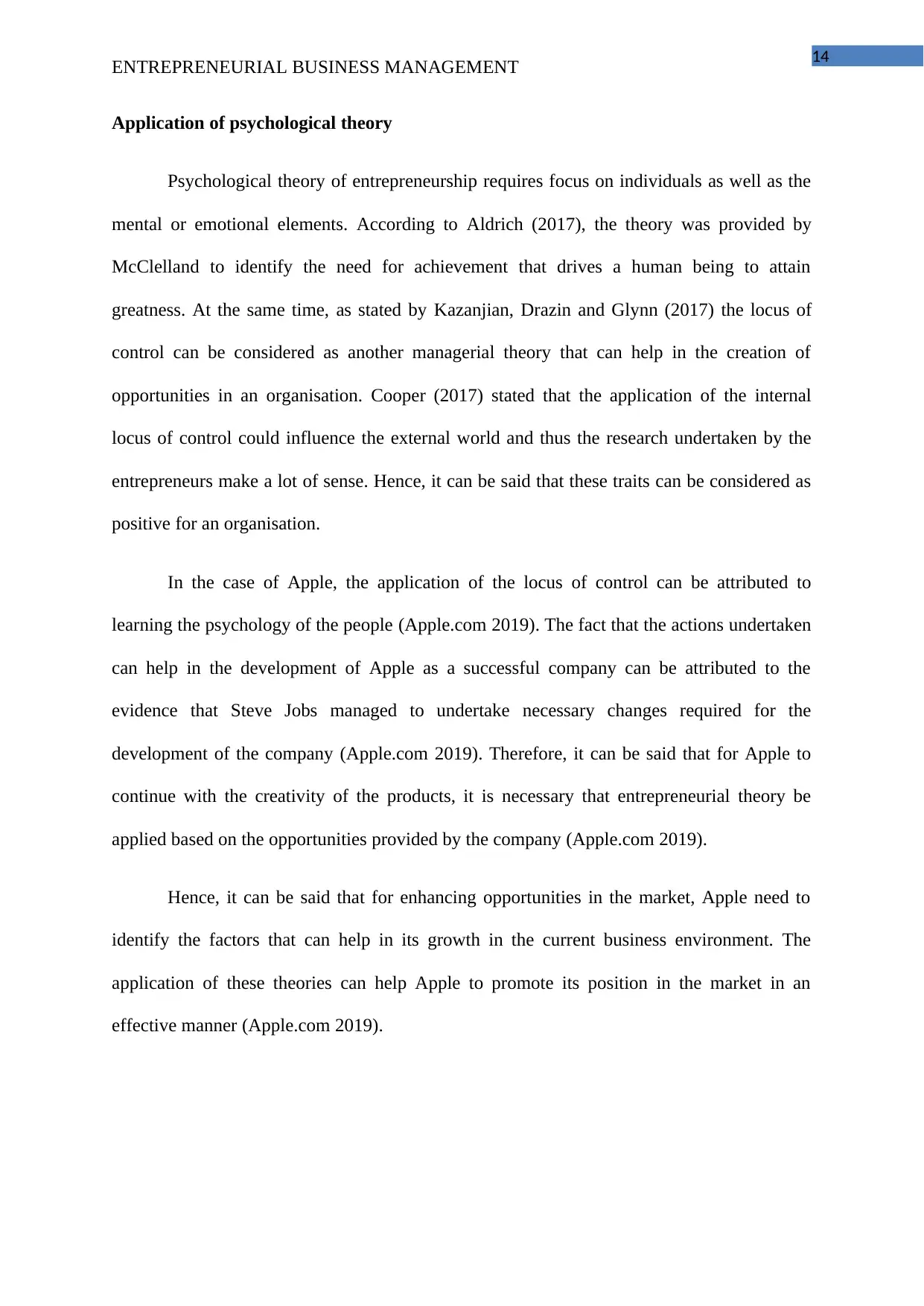
14
ENTREPRENEURIAL BUSINESS MANAGEMENT
Application of psychological theory
Psychological theory of entrepreneurship requires focus on individuals as well as the
mental or emotional elements. According to Aldrich (2017), the theory was provided by
McClelland to identify the need for achievement that drives a human being to attain
greatness. At the same time, as stated by Kazanjian, Drazin and Glynn (2017) the locus of
control can be considered as another managerial theory that can help in the creation of
opportunities in an organisation. Cooper (2017) stated that the application of the internal
locus of control could influence the external world and thus the research undertaken by the
entrepreneurs make a lot of sense. Hence, it can be said that these traits can be considered as
positive for an organisation.
In the case of Apple, the application of the locus of control can be attributed to
learning the psychology of the people (Apple.com 2019). The fact that the actions undertaken
can help in the development of Apple as a successful company can be attributed to the
evidence that Steve Jobs managed to undertake necessary changes required for the
development of the company (Apple.com 2019). Therefore, it can be said that for Apple to
continue with the creativity of the products, it is necessary that entrepreneurial theory be
applied based on the opportunities provided by the company (Apple.com 2019).
Hence, it can be said that for enhancing opportunities in the market, Apple need to
identify the factors that can help in its growth in the current business environment. The
application of these theories can help Apple to promote its position in the market in an
effective manner (Apple.com 2019).
ENTREPRENEURIAL BUSINESS MANAGEMENT
Application of psychological theory
Psychological theory of entrepreneurship requires focus on individuals as well as the
mental or emotional elements. According to Aldrich (2017), the theory was provided by
McClelland to identify the need for achievement that drives a human being to attain
greatness. At the same time, as stated by Kazanjian, Drazin and Glynn (2017) the locus of
control can be considered as another managerial theory that can help in the creation of
opportunities in an organisation. Cooper (2017) stated that the application of the internal
locus of control could influence the external world and thus the research undertaken by the
entrepreneurs make a lot of sense. Hence, it can be said that these traits can be considered as
positive for an organisation.
In the case of Apple, the application of the locus of control can be attributed to
learning the psychology of the people (Apple.com 2019). The fact that the actions undertaken
can help in the development of Apple as a successful company can be attributed to the
evidence that Steve Jobs managed to undertake necessary changes required for the
development of the company (Apple.com 2019). Therefore, it can be said that for Apple to
continue with the creativity of the products, it is necessary that entrepreneurial theory be
applied based on the opportunities provided by the company (Apple.com 2019).
Hence, it can be said that for enhancing opportunities in the market, Apple need to
identify the factors that can help in its growth in the current business environment. The
application of these theories can help Apple to promote its position in the market in an
effective manner (Apple.com 2019).
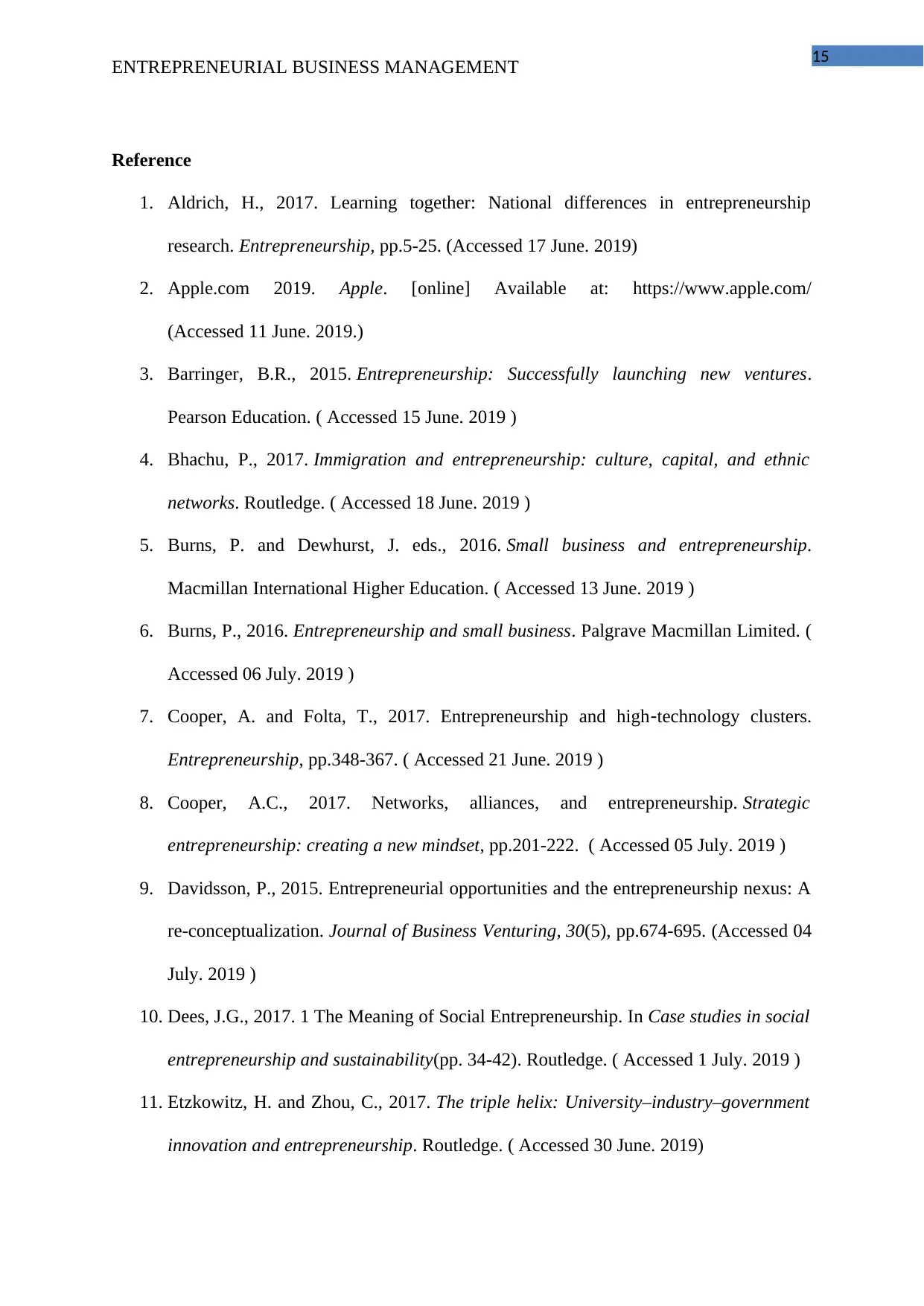
15
ENTREPRENEURIAL BUSINESS MANAGEMENT
Reference
1. Aldrich, H., 2017. Learning together: National differences in entrepreneurship
research. Entrepreneurship, pp.5-25. (Accessed 17 June. 2019)
2. Apple.com 2019. Apple. [online] Available at: https://www.apple.com/
(Accessed 11 June. 2019.)
3. Barringer, B.R., 2015. Entrepreneurship: Successfully launching new ventures.
Pearson Education. ( Accessed 15 June. 2019 )
4. Bhachu, P., 2017. Immigration and entrepreneurship: culture, capital, and ethnic
networks. Routledge. ( Accessed 18 June. 2019 )
5. Burns, P. and Dewhurst, J. eds., 2016. Small business and entrepreneurship.
Macmillan International Higher Education. ( Accessed 13 June. 2019 )
6. Burns, P., 2016. Entrepreneurship and small business. Palgrave Macmillan Limited. (
Accessed 06 July. 2019 )
7. Cooper, A. and Folta, T., 2017. Entrepreneurship and high‐technology clusters.
Entrepreneurship, pp.348-367. ( Accessed 21 June. 2019 )
8. Cooper, A.C., 2017. Networks, alliances, and entrepreneurship. Strategic
entrepreneurship: creating a new mindset, pp.201-222. ( Accessed 05 July. 2019 )
9. Davidsson, P., 2015. Entrepreneurial opportunities and the entrepreneurship nexus: A
re-conceptualization. Journal of Business Venturing, 30(5), pp.674-695. (Accessed 04
July. 2019 )
10. Dees, J.G., 2017. 1 The Meaning of Social Entrepreneurship. In Case studies in social
entrepreneurship and sustainability(pp. 34-42). Routledge. ( Accessed 1 July. 2019 )
11. Etzkowitz, H. and Zhou, C., 2017. The triple helix: University–industry–government
innovation and entrepreneurship. Routledge. ( Accessed 30 June. 2019)
ENTREPRENEURIAL BUSINESS MANAGEMENT
Reference
1. Aldrich, H., 2017. Learning together: National differences in entrepreneurship
research. Entrepreneurship, pp.5-25. (Accessed 17 June. 2019)
2. Apple.com 2019. Apple. [online] Available at: https://www.apple.com/
(Accessed 11 June. 2019.)
3. Barringer, B.R., 2015. Entrepreneurship: Successfully launching new ventures.
Pearson Education. ( Accessed 15 June. 2019 )
4. Bhachu, P., 2017. Immigration and entrepreneurship: culture, capital, and ethnic
networks. Routledge. ( Accessed 18 June. 2019 )
5. Burns, P. and Dewhurst, J. eds., 2016. Small business and entrepreneurship.
Macmillan International Higher Education. ( Accessed 13 June. 2019 )
6. Burns, P., 2016. Entrepreneurship and small business. Palgrave Macmillan Limited. (
Accessed 06 July. 2019 )
7. Cooper, A. and Folta, T., 2017. Entrepreneurship and high‐technology clusters.
Entrepreneurship, pp.348-367. ( Accessed 21 June. 2019 )
8. Cooper, A.C., 2017. Networks, alliances, and entrepreneurship. Strategic
entrepreneurship: creating a new mindset, pp.201-222. ( Accessed 05 July. 2019 )
9. Davidsson, P., 2015. Entrepreneurial opportunities and the entrepreneurship nexus: A
re-conceptualization. Journal of Business Venturing, 30(5), pp.674-695. (Accessed 04
July. 2019 )
10. Dees, J.G., 2017. 1 The Meaning of Social Entrepreneurship. In Case studies in social
entrepreneurship and sustainability(pp. 34-42). Routledge. ( Accessed 1 July. 2019 )
11. Etzkowitz, H. and Zhou, C., 2017. The triple helix: University–industry–government
innovation and entrepreneurship. Routledge. ( Accessed 30 June. 2019)
Secure Best Marks with AI Grader
Need help grading? Try our AI Grader for instant feedback on your assignments.
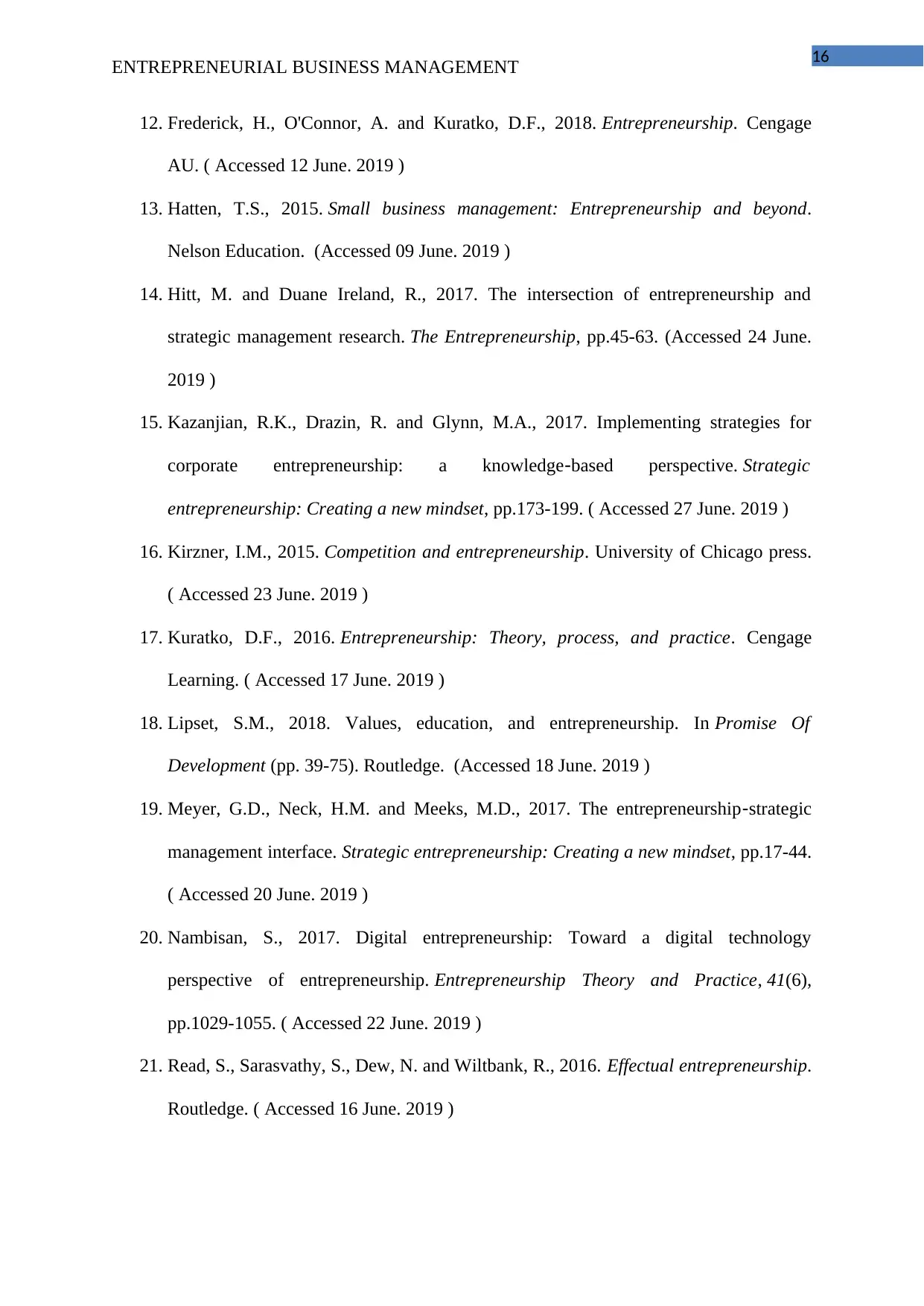
16
ENTREPRENEURIAL BUSINESS MANAGEMENT
12. Frederick, H., O'Connor, A. and Kuratko, D.F., 2018. Entrepreneurship. Cengage
AU. ( Accessed 12 June. 2019 )
13. Hatten, T.S., 2015. Small business management: Entrepreneurship and beyond.
Nelson Education. (Accessed 09 June. 2019 )
14. Hitt, M. and Duane Ireland, R., 2017. The intersection of entrepreneurship and
strategic management research. The Entrepreneurship, pp.45-63. (Accessed 24 June.
2019 )
15. Kazanjian, R.K., Drazin, R. and Glynn, M.A., 2017. Implementing strategies for
corporate entrepreneurship: a knowledge‐based perspective. Strategic
entrepreneurship: Creating a new mindset, pp.173-199. ( Accessed 27 June. 2019 )
16. Kirzner, I.M., 2015. Competition and entrepreneurship. University of Chicago press.
( Accessed 23 June. 2019 )
17. Kuratko, D.F., 2016. Entrepreneurship: Theory, process, and practice. Cengage
Learning. ( Accessed 17 June. 2019 )
18. Lipset, S.M., 2018. Values, education, and entrepreneurship. In Promise Of
Development (pp. 39-75). Routledge. (Accessed 18 June. 2019 )
19. Meyer, G.D., Neck, H.M. and Meeks, M.D., 2017. The entrepreneurship‐strategic
management interface. Strategic entrepreneurship: Creating a new mindset, pp.17-44.
( Accessed 20 June. 2019 )
20. Nambisan, S., 2017. Digital entrepreneurship: Toward a digital technology
perspective of entrepreneurship. Entrepreneurship Theory and Practice, 41(6),
pp.1029-1055. ( Accessed 22 June. 2019 )
21. Read, S., Sarasvathy, S., Dew, N. and Wiltbank, R., 2016. Effectual entrepreneurship.
Routledge. ( Accessed 16 June. 2019 )
ENTREPRENEURIAL BUSINESS MANAGEMENT
12. Frederick, H., O'Connor, A. and Kuratko, D.F., 2018. Entrepreneurship. Cengage
AU. ( Accessed 12 June. 2019 )
13. Hatten, T.S., 2015. Small business management: Entrepreneurship and beyond.
Nelson Education. (Accessed 09 June. 2019 )
14. Hitt, M. and Duane Ireland, R., 2017. The intersection of entrepreneurship and
strategic management research. The Entrepreneurship, pp.45-63. (Accessed 24 June.
2019 )
15. Kazanjian, R.K., Drazin, R. and Glynn, M.A., 2017. Implementing strategies for
corporate entrepreneurship: a knowledge‐based perspective. Strategic
entrepreneurship: Creating a new mindset, pp.173-199. ( Accessed 27 June. 2019 )
16. Kirzner, I.M., 2015. Competition and entrepreneurship. University of Chicago press.
( Accessed 23 June. 2019 )
17. Kuratko, D.F., 2016. Entrepreneurship: Theory, process, and practice. Cengage
Learning. ( Accessed 17 June. 2019 )
18. Lipset, S.M., 2018. Values, education, and entrepreneurship. In Promise Of
Development (pp. 39-75). Routledge. (Accessed 18 June. 2019 )
19. Meyer, G.D., Neck, H.M. and Meeks, M.D., 2017. The entrepreneurship‐strategic
management interface. Strategic entrepreneurship: Creating a new mindset, pp.17-44.
( Accessed 20 June. 2019 )
20. Nambisan, S., 2017. Digital entrepreneurship: Toward a digital technology
perspective of entrepreneurship. Entrepreneurship Theory and Practice, 41(6),
pp.1029-1055. ( Accessed 22 June. 2019 )
21. Read, S., Sarasvathy, S., Dew, N. and Wiltbank, R., 2016. Effectual entrepreneurship.
Routledge. ( Accessed 16 June. 2019 )
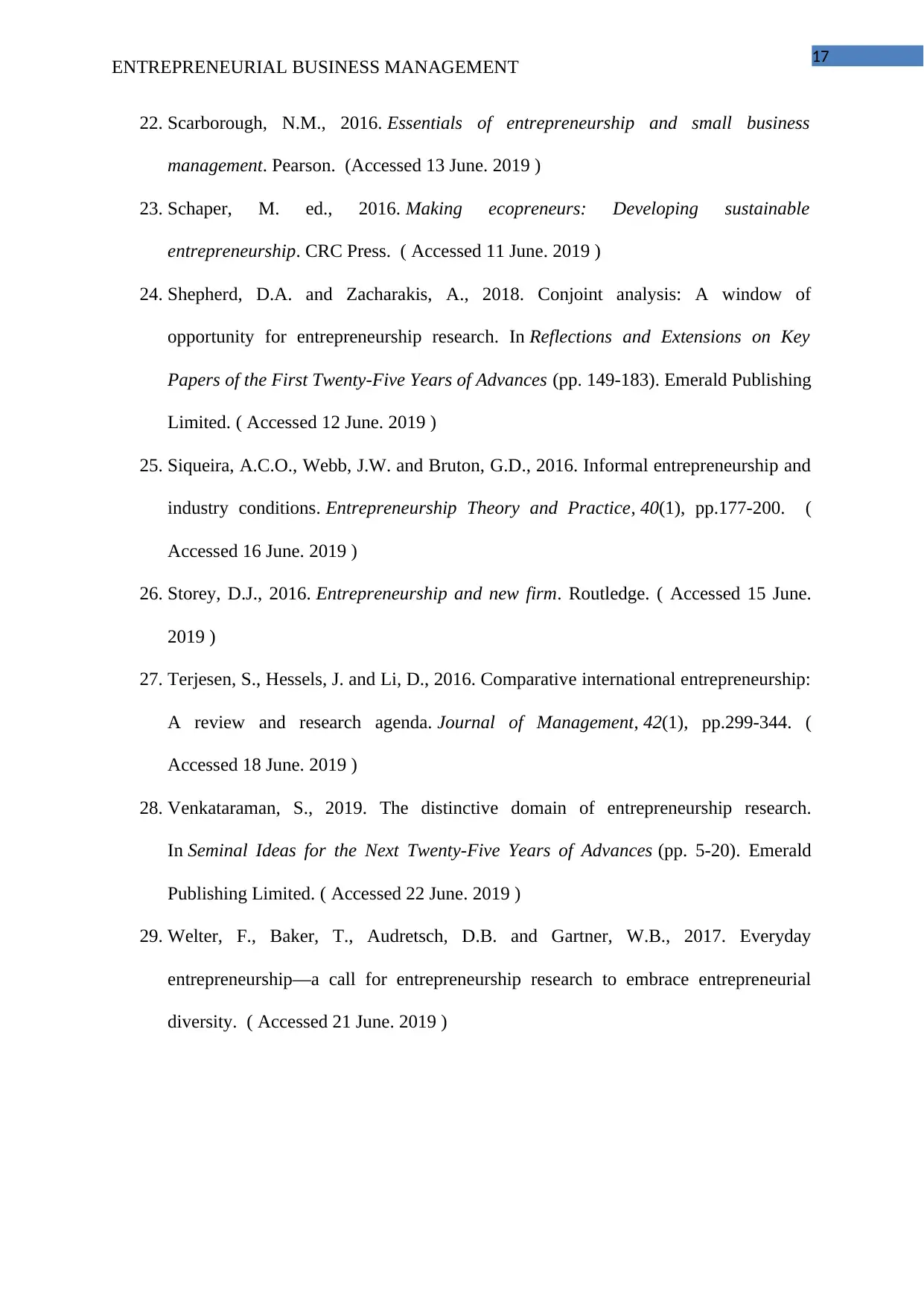
17
ENTREPRENEURIAL BUSINESS MANAGEMENT
22. Scarborough, N.M., 2016. Essentials of entrepreneurship and small business
management. Pearson. (Accessed 13 June. 2019 )
23. Schaper, M. ed., 2016. Making ecopreneurs: Developing sustainable
entrepreneurship. CRC Press. ( Accessed 11 June. 2019 )
24. Shepherd, D.A. and Zacharakis, A., 2018. Conjoint analysis: A window of
opportunity for entrepreneurship research. In Reflections and Extensions on Key
Papers of the First Twenty-Five Years of Advances (pp. 149-183). Emerald Publishing
Limited. ( Accessed 12 June. 2019 )
25. Siqueira, A.C.O., Webb, J.W. and Bruton, G.D., 2016. Informal entrepreneurship and
industry conditions. Entrepreneurship Theory and Practice, 40(1), pp.177-200. (
Accessed 16 June. 2019 )
26. Storey, D.J., 2016. Entrepreneurship and new firm. Routledge. ( Accessed 15 June.
2019 )
27. Terjesen, S., Hessels, J. and Li, D., 2016. Comparative international entrepreneurship:
A review and research agenda. Journal of Management, 42(1), pp.299-344. (
Accessed 18 June. 2019 )
28. Venkataraman, S., 2019. The distinctive domain of entrepreneurship research.
In Seminal Ideas for the Next Twenty-Five Years of Advances (pp. 5-20). Emerald
Publishing Limited. ( Accessed 22 June. 2019 )
29. Welter, F., Baker, T., Audretsch, D.B. and Gartner, W.B., 2017. Everyday
entrepreneurship—a call for entrepreneurship research to embrace entrepreneurial
diversity. ( Accessed 21 June. 2019 )
ENTREPRENEURIAL BUSINESS MANAGEMENT
22. Scarborough, N.M., 2016. Essentials of entrepreneurship and small business
management. Pearson. (Accessed 13 June. 2019 )
23. Schaper, M. ed., 2016. Making ecopreneurs: Developing sustainable
entrepreneurship. CRC Press. ( Accessed 11 June. 2019 )
24. Shepherd, D.A. and Zacharakis, A., 2018. Conjoint analysis: A window of
opportunity for entrepreneurship research. In Reflections and Extensions on Key
Papers of the First Twenty-Five Years of Advances (pp. 149-183). Emerald Publishing
Limited. ( Accessed 12 June. 2019 )
25. Siqueira, A.C.O., Webb, J.W. and Bruton, G.D., 2016. Informal entrepreneurship and
industry conditions. Entrepreneurship Theory and Practice, 40(1), pp.177-200. (
Accessed 16 June. 2019 )
26. Storey, D.J., 2016. Entrepreneurship and new firm. Routledge. ( Accessed 15 June.
2019 )
27. Terjesen, S., Hessels, J. and Li, D., 2016. Comparative international entrepreneurship:
A review and research agenda. Journal of Management, 42(1), pp.299-344. (
Accessed 18 June. 2019 )
28. Venkataraman, S., 2019. The distinctive domain of entrepreneurship research.
In Seminal Ideas for the Next Twenty-Five Years of Advances (pp. 5-20). Emerald
Publishing Limited. ( Accessed 22 June. 2019 )
29. Welter, F., Baker, T., Audretsch, D.B. and Gartner, W.B., 2017. Everyday
entrepreneurship—a call for entrepreneurship research to embrace entrepreneurial
diversity. ( Accessed 21 June. 2019 )
1 out of 18
Related Documents
Your All-in-One AI-Powered Toolkit for Academic Success.
+13062052269
info@desklib.com
Available 24*7 on WhatsApp / Email
![[object Object]](/_next/static/media/star-bottom.7253800d.svg)
Unlock your academic potential
© 2024 | Zucol Services PVT LTD | All rights reserved.





